Text
PLAY EXHIBITIONS
Colour, Art and Play Therapy.
The second exhibition was on play. Exploring how play can act as a creative outlet for those suffering with their mental health and how free play, making and creating is a fantastic medium for adults as well and children. Showing examples of games from the Bauhaus movement, through to outdoor play and even lego. The exhibition is full of games and activities for children and is extremely reminiscent of childhood and the fun that came with being that age. The website describes the exhibition as ‘Play Well’ explores how play transforms both childhood and society. Using displays of historic toys and games, artworks and design, this exhibition investigates how play develops social bonds, emotional resilience and physical wellbeing. The exhibition includes: images of children at play in the street, in playgrounds and beyond; makeshift and commercially produced toys; digital games and a larp (live-action role play) space by artist Adam James”. Construing that play is more than just silly games, that it does aid wellbeing and help ‘emotional resilience’, show in the work of INSERT EXAMPLE. Playing with CLAY? SSS was used as a tool to heal trauma.
The curators of the exhibition Sharmacharia, Sargent and Peto also discussed the importance of the children. They said that they “wanted to make sure the fun of play came across, too. Putting children centre stage was key.” I find this really interesting as children's emotional wellbeing might not be at the forefront of everyones mind. Thinking childhood can be an easy time.
https://wellcomecollection.org/exhibitions/XSg-7xEAACcAGVXc
I decided to re visit the school as the children were previously familiar with me and we had built some rapport for them to hopefully feel comfortable and relaxed in my company. This time, instead of showing more of my artwork, I decided to let them have some creative time. With one interesting avenue discussed as far being ‘free-play’. Free play “ INSERT QUOTE”
“Children are highly motivated to play, although adults find defining and understanding children’s play a challenge. All aspects of development and learning are related in play, particularly the affective and cognitive domains. When children have time to play, their play grows in complexity and becomes more cognitively and socially demanding. Through free play children:
explore materials and discover their properties
use their knowledge of materials to play imaginatively
express their emotions and reveal their inner feelings
come to terms with traumatic experiences
maintain emotional balance, physical and mental health, and well-being”
http://www.playengland.net/wp-content/uploads/2015/09/free-play-in-early-childhood.pdf
to facilitate this information I constructed a the series of activities to complete with the children. In order to analyze the children's response and enumerate the color choices that they prefer and uplift them through a series of creative workshops. To amass my primary research on play and colour.
0 notes
Text
SONIA BOYCE DOCUMENTARY
I wanted to find out a little more about Black British art, artwork about peoples diaspora experiences and art on identity. I have watched a few documentaries which I would reccomend for anyone interested in learning more about the subject and some more artists and their work.
There was a clip on Sonia Boyce on the Tate website. She said she created her work as there was “ a very very limited range of images of African diasporic women - they were either hypersexual ie: a prostitute or a mummy sort of figure of service somehow”. and went on to compare this by saying “ which was a stark contrast to the amount of images around white femininity”. Which I very much agree with. Since I’ve really gotten into art I noticed this throughout GCSE art, college and now in university I have always wanted to created minority positive art work. Because all of the “big” “main” galleries are always slave portraits or photographs on how the slaves looked. Alot of other documentation are racist caricature and imagery. Refering back to the part of hyper sexualised imagery- I also agree. Often, images and photographs are exgerattive of our features and especially historically are derogatory. The Jezebel caricature and other cartoons depicting overly sexual women and disturbingly the jezebel caricatures are often very young looking.
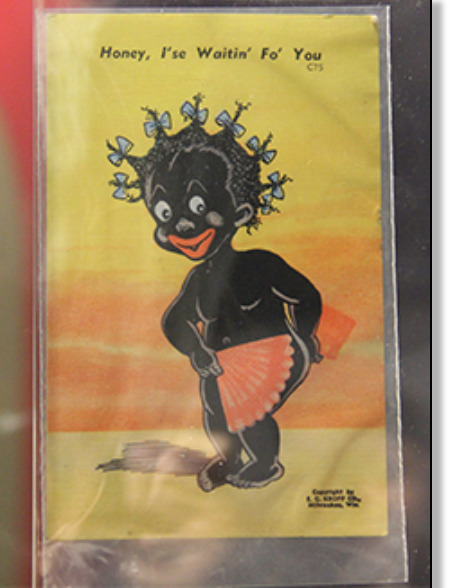
I read further into this issue on the Feris education website which has the Jim Crow museum. “The portrayal of black women as lascivious by nature is an enduring stereotype. The descriptive words associated with this stereotype are singular in their focus: seductive, alluring, worldly, beguiling, tempting, and lewd. Historically, white women, as a category, were portrayed as models of self-respect, self-control, and modesty - even sexual purity, but black women were often portrayed as innately promiscuous, even predatory. This depiction of black women is signified by the name Jezebel.”
“ It is true that the "tragic mulatto" and "Jezebel" share the reputation of being sexually seductive, and both are antithetical to the desexualized Mammy caricature; nevertheless, it is a mistake to assume that only, or even mainly, fair-complexioned black women were sexually objectified by the larger American society. From the early 1630s to the present, black American women of all shades have been portrayed as hypersexual "bad-black-girls." And this horrible ideology is thought to go back to slavery “ that White Europeans, locked into the racial ethnocentrism of the 17th century, saw African polygamy and tribal dances as proof of the African's uncontrolled sexual lust. Europeans were fascinated by African sexuality.” Even through in the 1950′s things like “ gollywog” dolls were common. But the Jezebel imagery was everywhere from the cinema, to post cards to drink stirrers. And this kind of negative imagery needs to be replaced with multitudes of positive and empowering art work for people of colour, black women, women and begin to change ideology of people and have these kinds of artworks in galleries and in books.
I think the fetishisation of black women or women of colour is a problem. I previously spoke about “ exotic” being a far too familiar term when receiving “ compliments” from men. And how this even creates a feeling of distance and difference. When I was born in Ipswich in Suffolk, I would say I’m very far from exotic... And the “lightie” comments from being mixed race. All of these comments and mindsets are negative for progression in our community and believe body positive and black positive images will help.
Sonia Boyce was also part of the Black art movement in the 1980′s and looked at the cultural and racial differences in her area. Which she describes as “ tense” and from a young age realising this.
And she said to people watching to “ do it because you’re thinking it feeling it and it’s got to be expressed”.
https://www.youtube.com/watch?v=vRB6H06UpJ4 - VIDEO SONIA BOYCE
Ferris.edu. (2019). The Jezebel Stereotype - Anti-black Imagery - Jim Crow Museum - Ferris State University. [online] Available at: https://www.ferris.edu/jimcrow/jezebel/ [Accessed 27 Mar. 2019].
0 notes
Photo
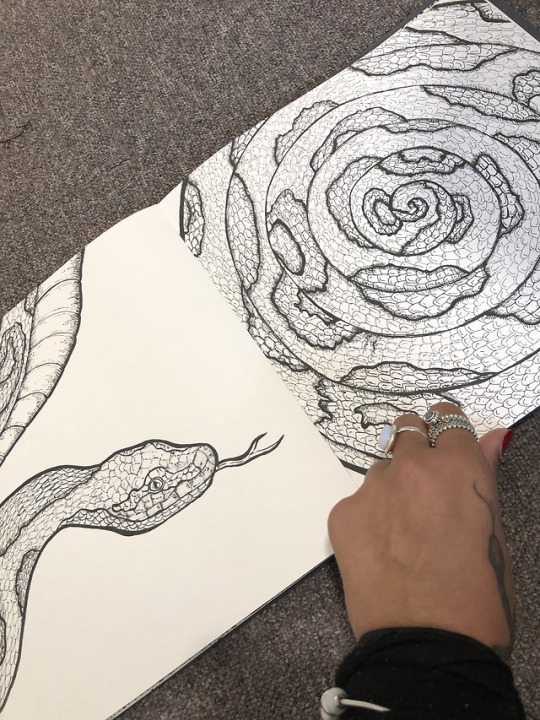
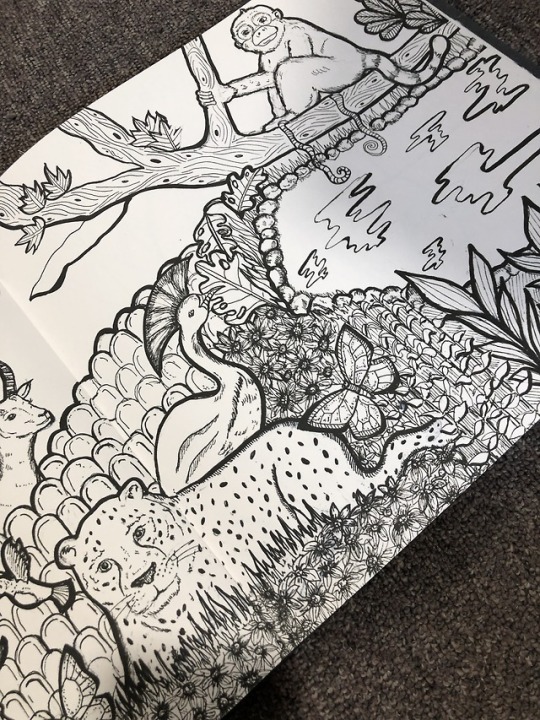
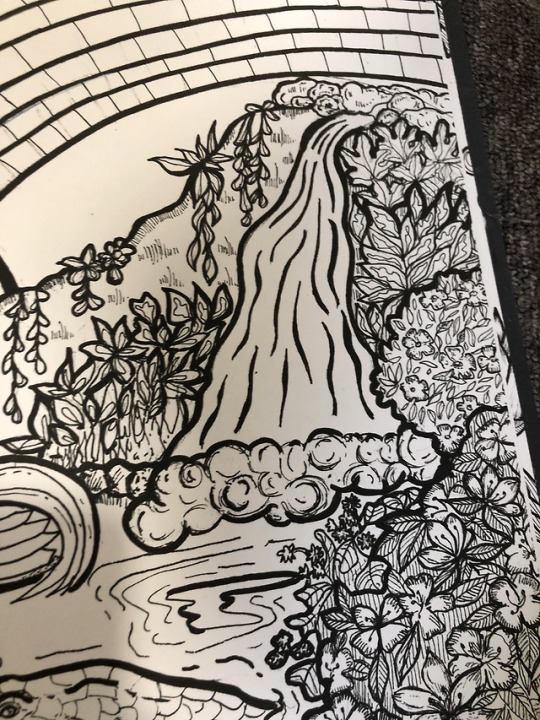
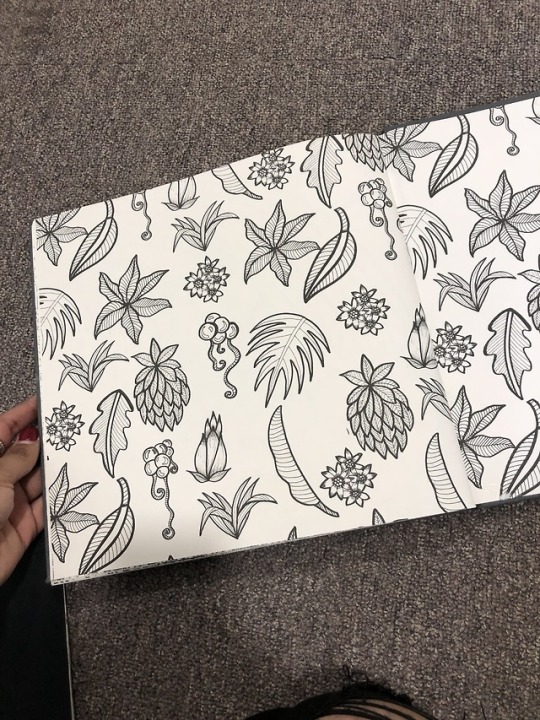
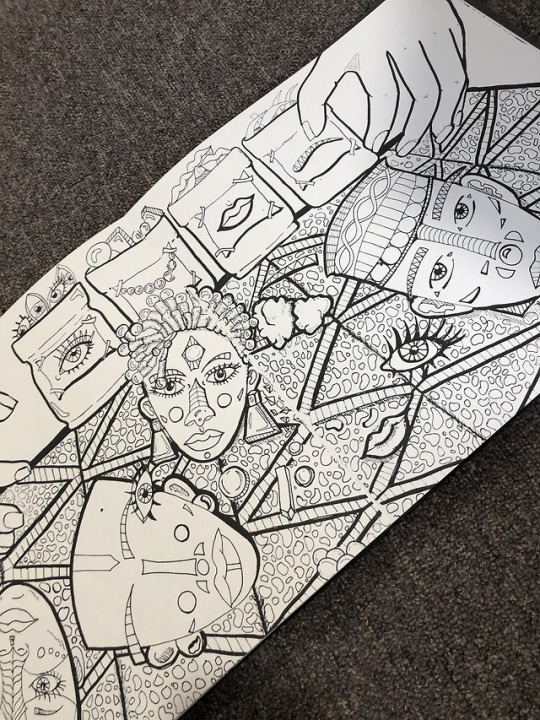
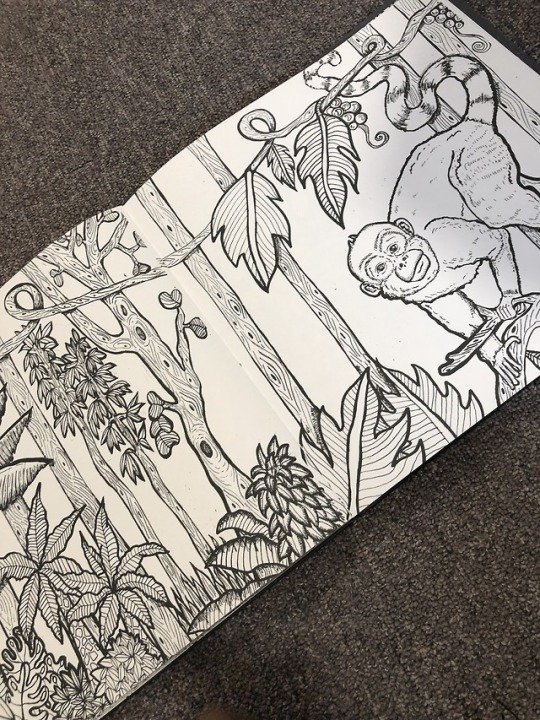
Here are some photographs of the final colouring book. I edited them on Photoshop and then arranged them on In Design and then printed them all double sided on matte 220gsm paper. So they can easily be coloured in pencil and in pen as the papers thick enough that it won’t go through. Once it all printed I staple bound it and trimmed the pages to size on the guillotene. And then went onto make a hard back cover with book cover paper and mount board and glued it together and then glued the end pages to the board to make a finished book and I’m really pleased with the result. Although meant for children I think the detail and pattern would also be appropriate for a “mindfulness” colouring book, the relaxation ones for adults. I kept inspiration from illustrators like Kay Nielson for the ornamental areas and all the fine detail. I also think I encapsulated the story of Mawu- and the traditional West African mythology also well. With black godess’s for children to colour in and feel inclusive to them.
0 notes
Photo
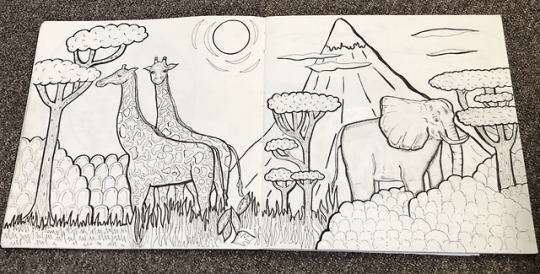
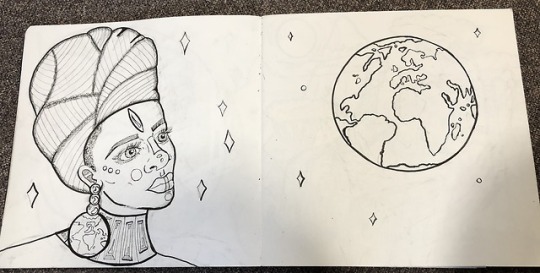
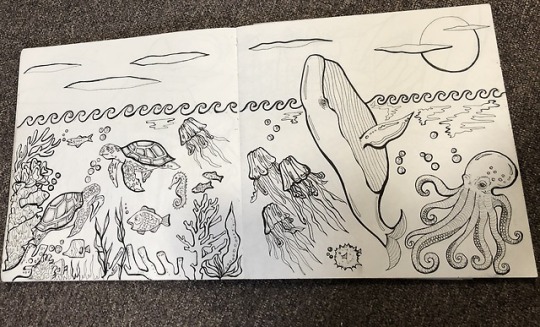
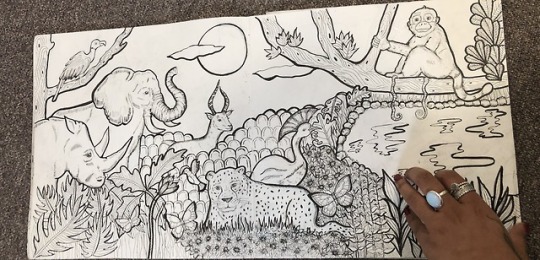
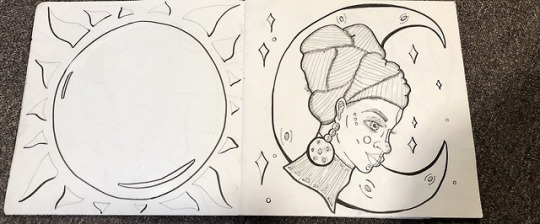
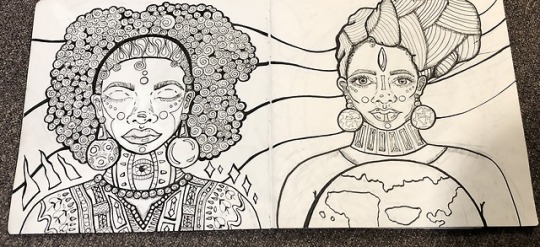
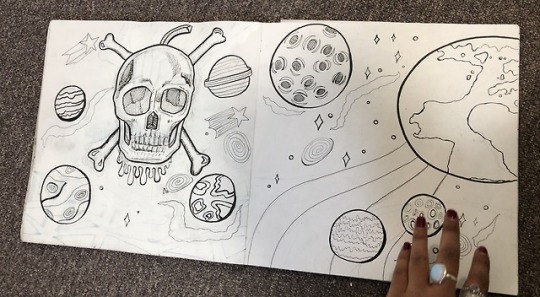

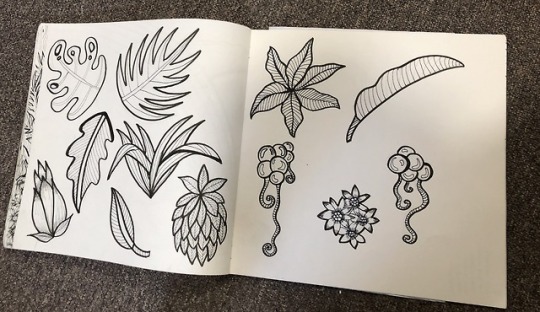
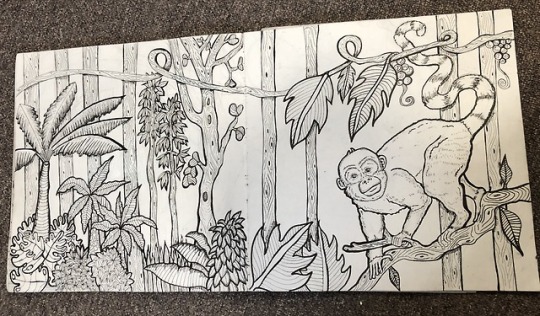
WORK UPDATE:
Here are some photographs of the original ink drawings in my sketchbook. I will scan these in and use them for my children’s colouring book. I will scan them into Photoshop and edit them by removing the background and neatening them up a bit, removing pencil lines ect. And I will make a pattern for my end paper from these leaves.
0 notes
Photo
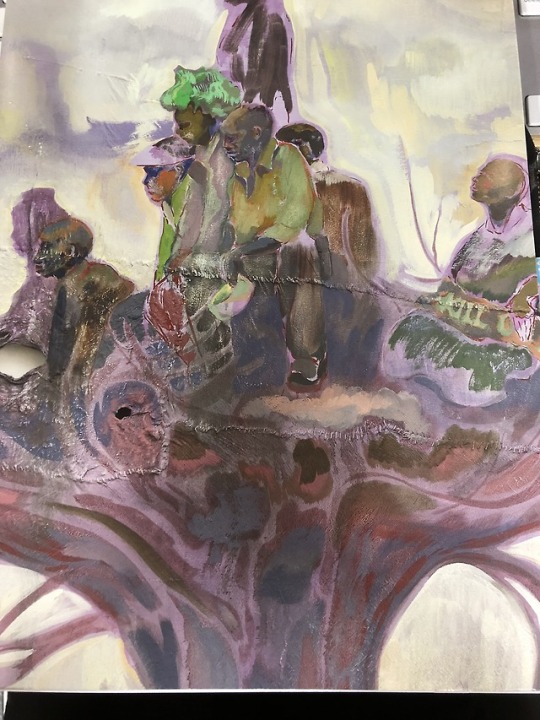
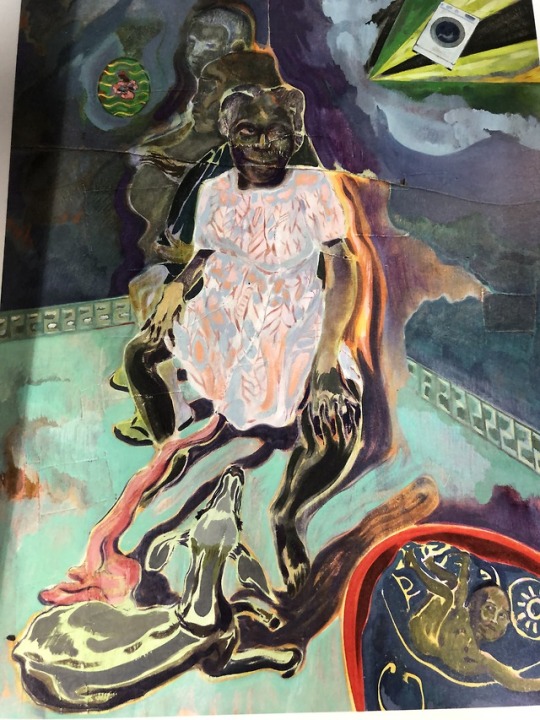
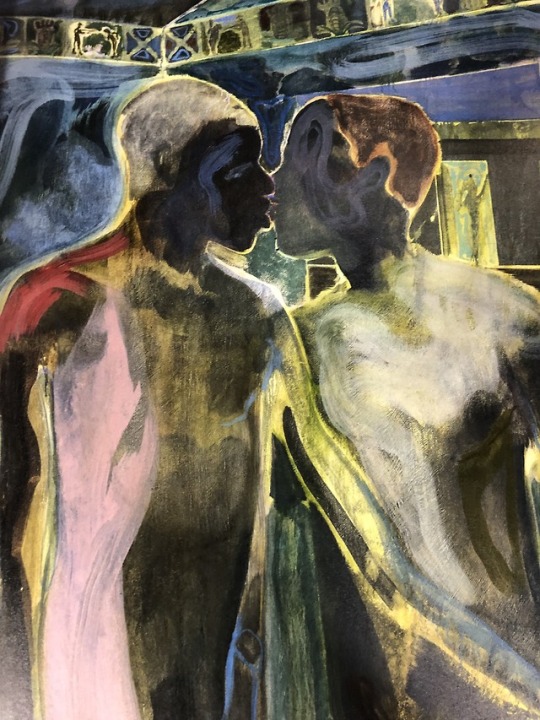
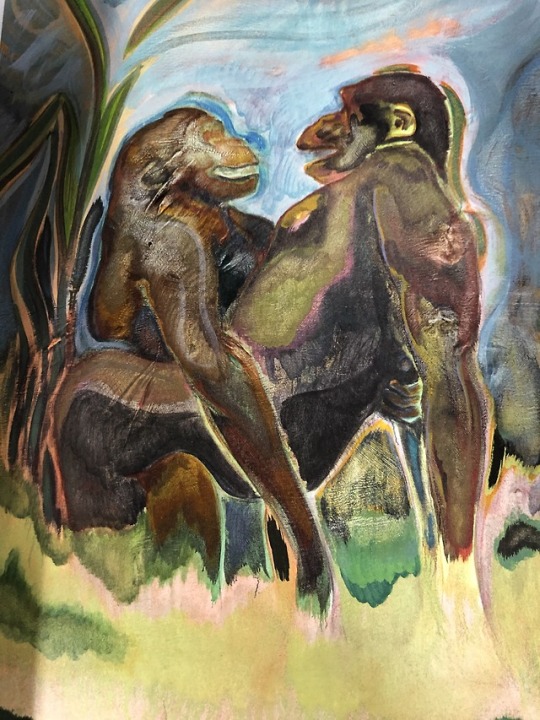
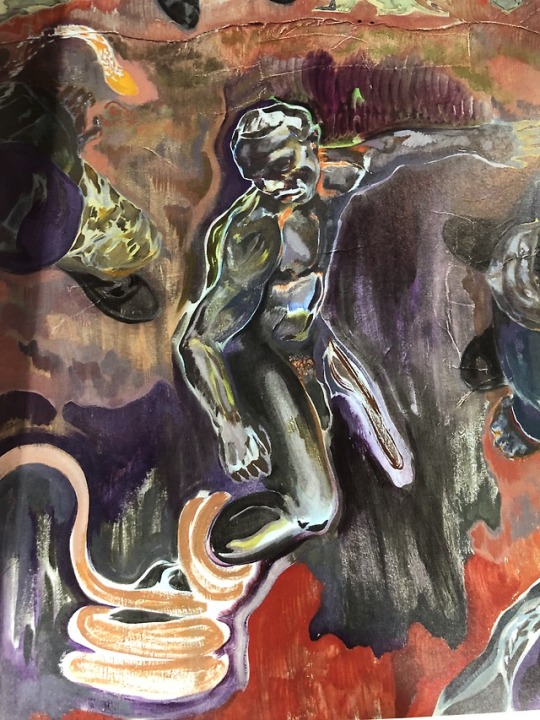
These are some photographs that I have taken from the book I have been referencing. Micheal Armitage: White Cube South London Gallery.
1 note
·
View note
Text
MICHEAL ARMITAGE
ARTIST REFERENCE/EXHIBITION/READING
I came across an artist in London who I loved called Micheal Armitage. He works in many ways collecting photographs, doing graphite drawings but the work I loved the most was his paintings. He paints with oil on Lubugo, a traditional bark cloth from Uganda.
I was initially just drawn to his work from the colours and the rich, deep colours he uses for his portraits of African people against the light washes he uses in the backgrounds. Also, the bold pops of colour he incorporates within elements like clothing or ornaments in the background. And the contrast between light and dark he creates very powerful imagery.
Armitage is a Black-British artist with Kenyan-British origins; he deals within his art work a lot of similar sociocultural aspects that I have been exploring. Often depicting Africa and African people his work is very autobiographical and this in conjunction with his life in South London shows the two world perspective that dual heritage/ mixed race/ multi nationality artists are able to show within artwork. And the juxtapostition between the two different worlds in which he exists.
Within Armitage’s work is an abundance of culture. From his subject focus and the materials he uses. I had not heard of Lubugo before and after researching further into his work I found an article reviewing Armitage’s work which described the process.Alastair Sooke for the telegraph explained “One of the distinctive aspects of Armitage’s technique is that he paints not on canvas but on bark cloth harvested from mutuba trees. In Uganda, bark cloth is a traditional fabric used for burial shrouds and ceremonial clothing – although Armitage first came across it in a shop peddling tourist tat in Kenya. By stitching together erratically shaped pieces of the stuff, Armitage creates large painting surfaces, sometimes two or even three metres across, characterised by all sorts of irregularities – ripples and ridges, divots and dents – which become elements in his compositions.” Even careful consideration for the materials that he is sourcing. Another reason I love his work.
I also brought a book on him from the White cube. To see some more of his work and read some more about him as he is a massive inspiration and I am a big fan.
In the Roger Malbert speaks about him and explains more about his background. Roger Malbert is an artist and curator and was once head of touring at the Hayward Gallery. He says Armitage was born in Kenya and had grown up there; and how it is the place he still considers “home”. He goes on to say “ As a Kenyan-British painter he occupies a liminal space familiar now to many African artists; who is they are successful internationally, tend to live between two worlds: their country of origin and some versions of diaspora. The complexities of such situations can be propituous for an artist, producing a particular blend of sympathies, insights and perhaps a degree of alienation- or creative distance- from both cultures, combined with a passionate sense of purpose”. Within that statement I think he encapsulates perfectly the beauty of this kind of artwork. He carries on to explain how he grew up in an “inter-racial house hold” which I believes adds an additional element of culture, backgrounds and interactions which add to a persons experience.
He continues to explain how his palette is influenced by “Gaugin’s sumptuous palette” . Paul Gaugin was a fine artist from the 1800′s and died in 1903 and was a post-modernist painter. He also painted in oils and used a muted colour palette. This influence from European art is also interesting against his subject matter of Africa and his interpretation of paradise is also another interesting element within his work. Creating another juxtaposition within his paintings.
I like this account and how he describes his work and the genre. The themes consist of similar work to the majority of the black British artist I have looked at and the other readings I have done; which all directly link to my exploration with African culture and socio-political issues surrounding being a black / mixed race person and the broader theme of identity and duality.
Alastair Sooke (2019). Ravishing and provocative artist who could be destined for greatness - Michael Armitage: The Chapel, South London Gallery, review. [online] The Telegraph. Available at: https://www.telegraph.co.uk/art/what-to-see/michael-armitage-chapel-south-london-gallery-review/ [Accessed 27 Mar. 2019].
Honey Luard. Micheal Armitage. (2017) Micheal Armitage: White cube South London gallery (book) pg 78. Roger Malbert.
0 notes
Text
INFOGRAPHICS
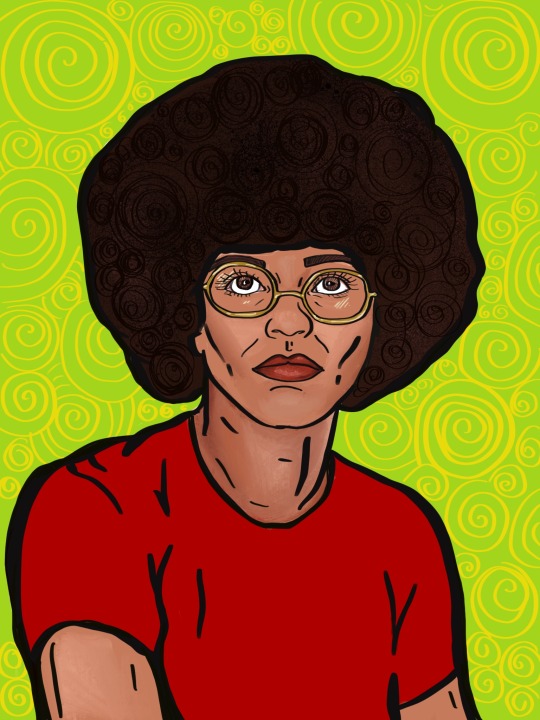
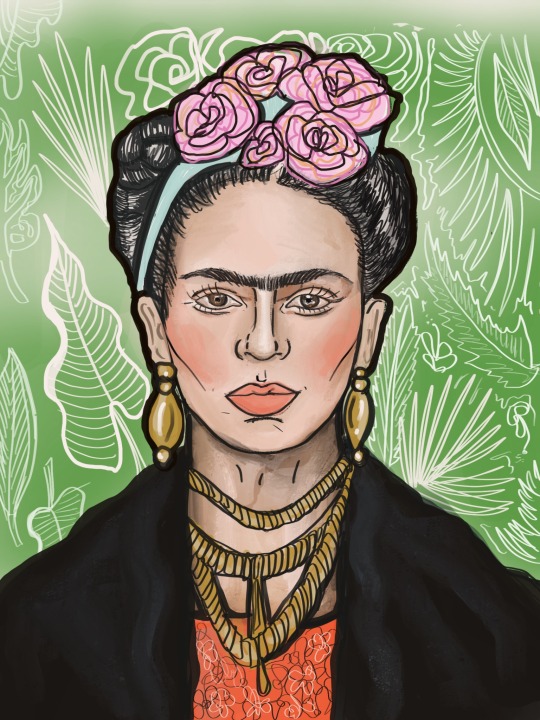
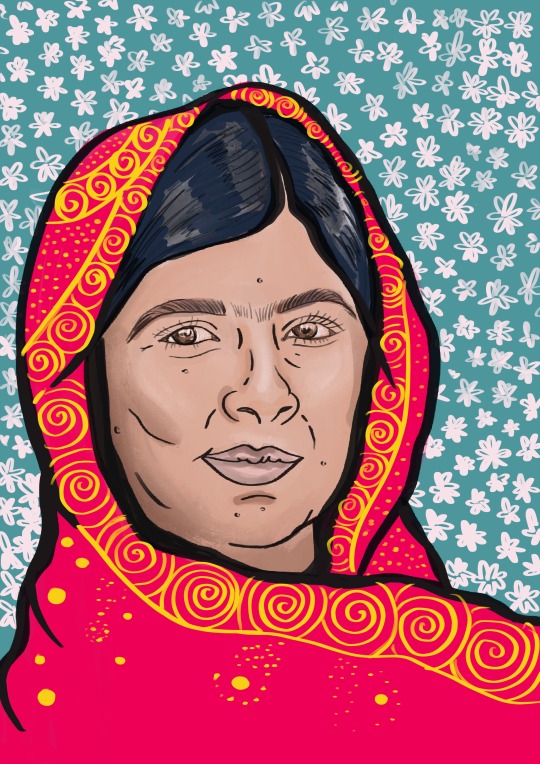
Here are some of my artworks so far relating to this project. I have collected information on these women, inspiring quotes that they’ve said. And combined this with digital portraits that I’ve painted and will print out and bind into a hard back book for a prototype for the type of book I’d like to make and have published.
According to the Oxford English Dictionary, an infographic (or information graphic) is “a visual representation of information or data”. but a website specialising in info graphics and templates says “ An infographic is a collection of imagery, charts, and minimal text that gives an easy-to-understand overview of a topic.” Which is what I’m trying to do have the imagery and the colours as the focus with some - of the most important highlights of their careers/lives.
Below are some of the screenshots of the pages coming together on in design and once I finish painting the rest of the portraits. I will print and bind the book and post photographs of the process.
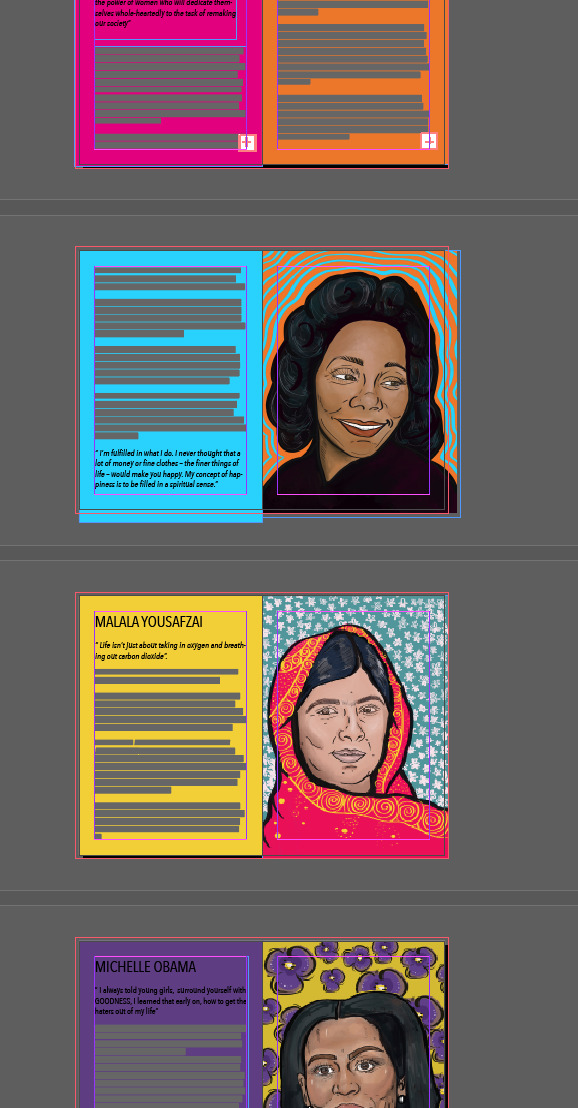
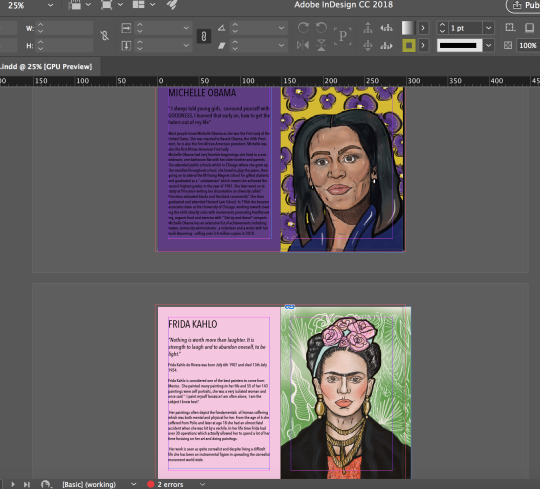
Venngage. (2019). What is an Infographic? Infographic Examples, Templates, and Design Tips - Venngage. [online] Available at: https://venngage.com/blog/what-is-an-infographic/ [Accessed 26 Mar. 2019].
0 notes
Photo
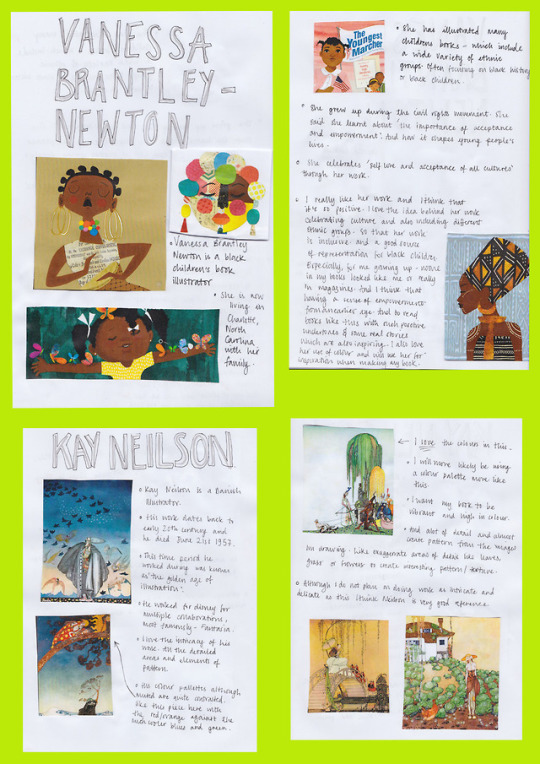
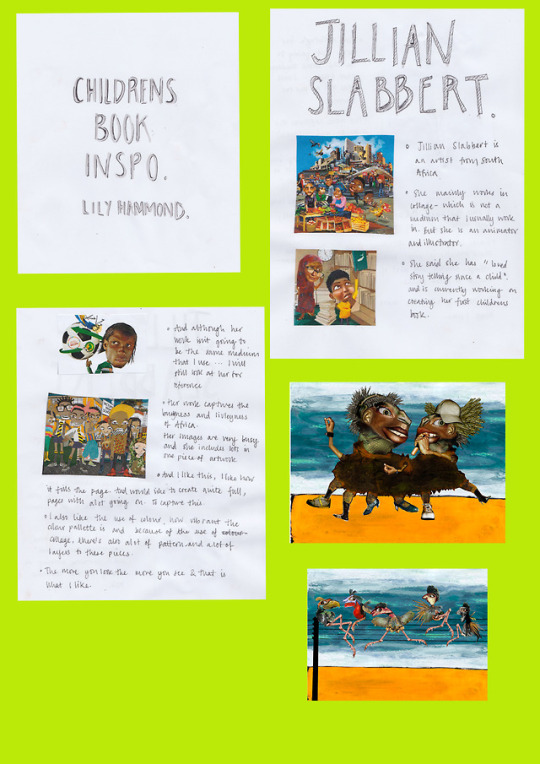
Pook Press. (2019). Kay Nielsen Illustrator Biography | Life, Art and Illustration. [online] Available at: https://www.pookpress.co.uk/project/kay-nielsen-biography/ [Accessed 26 Mar. 2019].This is some of my research and references I found whilst creating my children’s book and colouring book.
I looked firstly at Kay Neilson a Danish illustrator, focusing mainly on the detail and the pattern within his work and I will be paying attention to creating decorative and interesting work to make it even more engaging to the children and in repeated areas like leaves and flowers make quite ornament.
I then looked at Vanessa Brantley Newton, who is a black children’s book illustrator. She does super positive images of influential black people and uplifting and inclusive books. I like this idea and I think that it is important. She ties into my colouring book/ childrens book and also the other work Im creating for paul my info graphic book of illustrations and facts and quotes on minority women from minority groups, whether political, artists or writers. Show casing and highlighting black talent.
Finally I had a look at the South African artist Jillian Slabbert. In the research above I commented on her use of medium- collage, and although it is not a medium I have used yet. I will be using for paul in some mixed media artwork that she inspired me to create. Using some print some textile and some painting. But for the books I am making I want to use vibrant, bright colours to enhance the positive bright message I am trying to create and invoke this message through this colour is a good way to create the mood I am setting .
INFORMATION FROM:
Painted Words. (2019). Vanessa Brantley Newton - Painted Words. [online] Available at: https://painted-words.com/portfolio/vanessa-brantley-newton/ [Accessed 26 Mar. 2019].
OkayAfrica. (2019). 10 African Children's Illustrators To Know. [online] Available at: https://www.okayafrica.com/african-childrens-illustrators-to-know/?rebelltpage=11&page=10 [Accessed 26 Mar. 2019].
Pook Press. (2019). Kay Nielsen Illustrator Biography | Life, Art and Illustration. [online] Available at: https://www.pookpress.co.uk/project/kay-nielsen-biography/ [Accessed 26 Mar. 2019].
0 notes
Text
READING- BLACK ARTISTS IN BRITISH ART.
I brought another book. Black artists in British art: a history since the 1950′s. By Eddie Chambers. The book gives an insight into different Black artists who were either born in Britain or now reside in Britain from painters, to sculptors to photography. Speaking about their work, their achievements, their journey and their exploration of identity and being a black person through their artwork.
0 notes
Text
READING- MIXED RACE SUPER MAN
I brought some books throughout this project which I felt would be relevant for my project. All centred around identity or race. The first book I read was “ Mixed-Race Super man written by Will Harris.
Will Harris is Indonesian and english, he grew up in England and has written this very personal essay with his experience as a man of mixed heritage and other examples of celebrities who are also mixed race eg - Barack Obama and Keanu Reaves.
Harris in his introduction describes his work “ Mixed Race Superman asks what it means to be mixed race in an increasingly divided world. In an era where a man endorsed by the Klu Klux Klan can sit in the White House, Will Harris considers two very different supermen- Barack Obama and Keanu reaves - each transformed the confusion of a mixed heritage into a heroic identity” also delving into “ exploration of race, identity and masculinity” highlighting the juxtapostion of previously having a mixed race President as opposed to the new some may say “ racist” president who seems evident to cause more divide and controvasy, mentioning his support from Neo-Nazi, and other white supremacy groups...
In conjunction with his It speaks about a time period in which tensions were high with the police, due to multiple injustices and these hate crimes and stabbings. Especially, as these issues are with in the Black community. And although tensions are not as bad here in the UK we do still have a huge problem with stabbings and gang violence still especially in London. And in the US, huge problems between the police and people in minority communities. Some of my family live in America and there is a huge divide between communities- Spanish, Black, White, Jewish in addition to this unimaginably obvious divide theres a big fear of the police as a person of colour.
He also speaks about his experience growing up in London, when the conversations about race weren’t happening as much as now. He speaks about “ Vague statements about multi-culturalism and the need for intergration” sometimes making the news. And a sense of embarrassment that they were talking about “ people like him”.
Highlighting events of racial hostility in London, and the hate crime against Stephen Lawrence a heart breaking and known case to me. He talks about the negligence from the police and how they mishandled hate crimes at the time. “ Stephen Lawrence was stabbed to death in South London while waiting for the bus. The metropolitan police’s mishandling of the case brought back memories of the 1980′s: of stabbings being un-investigated, the violent and indiscriminate use of stop and search, the shooting of Cherry Groce which led to the 1985 Brixton Riot. A few months after being arrested Stephen Lawrence’s Killer walked free. In 1995 Wayne Douglas was killed in police custody and another riot broke out in Brixton.”
Also speaking about societies expectancy for immediate results. With the New Labour manifesto in 1997 claiming that “our attitudes towards race, sex and sexuality have changed fundamentally”. and questions this statement “ Though we were a racist society- we aren’t anymore”. Which raises questions how can we expect such an immediate result and expect change when racism is institutionalised within the police, education , laws. With stops and searches for more black people, or black people driving nice cars, black people loosing jobs for traditional hair styles and being treated disgustingly by the police. and claiming that people have to “ combine change and social stability”. The evident issue is the only discussions raised are not discussions its a statement.
Harris goes on to say. “ there wasn’t much social stability for Indian families who had their windows smashed in” and “ for the South London community Stephen Lawerence had lived in”. Almost as though the social stability must come from minority groups and victims when in fact the change comes from much higher up, and is much bigger than a statement. It needs to be a conversation about race, and division and HOW to create social stability and in subsequently creating change within communities.
He continues, “ They didn’t want to appear callous, overlooking the needs of ethnic minorities; nor did they want to appear weak, giving into the demands of identity based ‘ pressure groups’. Multiculturalism gave them the perfect rallying cry and emollient, offending no one by including everyone”. I believe this mind set is still very prominent today. ‘ offending no one by including everyone”. This is similar to the current movement, black lives matter. Where by people who are protesting and trying to create change towards police brutality and the black community. People say in response to this movement “ all lives matter”. But by generalising a specific race related issue you then restrict the rights of people ( minority groups) who need protection and who need the social change. White privilege and male privilege are two problems which are very much in bedded into our society. And there is need to distinguish difference between different ethnic groups, because the issues I may face, as opposed to a muslim woman or a black woman would all be different and are all so individual and personal you can not begin to blend all this social, cultural and political aspects for everyone as the “ same” and “ equal”. Because right not for a lot of people of colour it is not, and there for must be distinguished as different.
“ Now there was a politician who not only looked different, but talked beautifully- and knowingly- of his mixed race up bringing. Here was a story that was long and painful but seemed to bend implacably towards justice”. And although throughout this book I found the kind of superman comparisons slightly bizarre, but this statement I did relate to. Growing up I didn’t have anyone really who looked like me in cartoons, books, or many role models only celebrities maybe singers or models who were mixed race. But to see Obama, a man who looks like us as the president of the US, was indescribable. It was something that was almost was unimaginable with the deep rooted history of slavery, segregation , racism that they would have a black president and almost highlighted this idea that anything could be possible and the world was changing and mindsets were changing. It was exciting and almost I understand this superman complex he speaks of, this invincible man- despite all of societies hurdles, and the difficulties that arose he became president and created a time of hope .
Unfortunately for me, Harris doesn’t refer to examples of women in history or currently, it is very male orientated. However, as an account of his personal experience I do understand as throughout the exploration for my identity, I have looked at goddesses, female artists and women who have inspired me as these women of colour I relate to personally and have been “ role models” to me. As Keanu Reeves is a celebrity in which Harris looks up to. He does touch on a few times, about feminism, gender-fluidity and trans people.
In conclusion I think that Harris gave a very insightful and personal account of his experience as a man of mixed heritage. I agree with many of his points throughout his essay and discusses similar socio-cultural issues which I have explored.

HARRIS, W. (2019). MIXED-RACE SUPERMAN.]: MELVILLE House, p.1.
HARRIS, W. (2019). MIXED-RACE SUPERMAN. [: MELVILLE House, p.15.
HARRIS, W. (2019). MIXED-RACE SUPERMAN. : MELVILLE House, p.15.
HARRIS, W. (2019). MIXED-RACE SUPERMAN. [Place of publication not identified]: MELVILLE House, p.15.
HARRIS, W. (2019). MIXED-RACE SUPERMAN: MELVILLE House, p.17.
HARRIS, W. (2019). MIXED-RACE SUPERMAN. : MELVILLE House, p.22.
0 notes
Photo
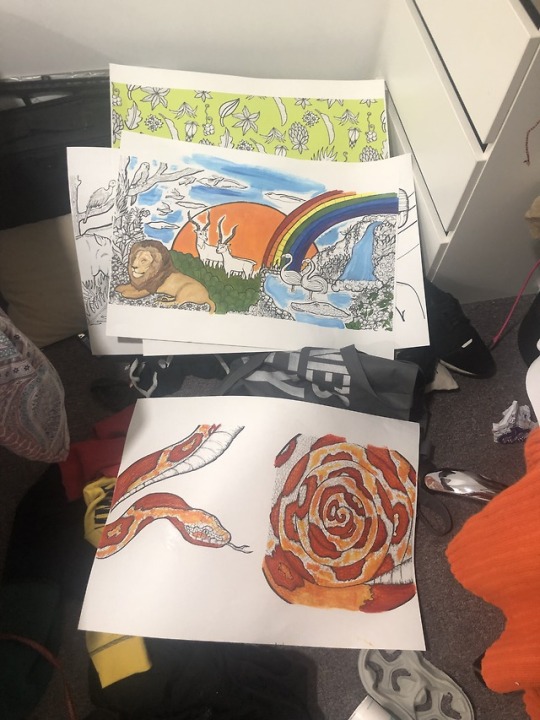
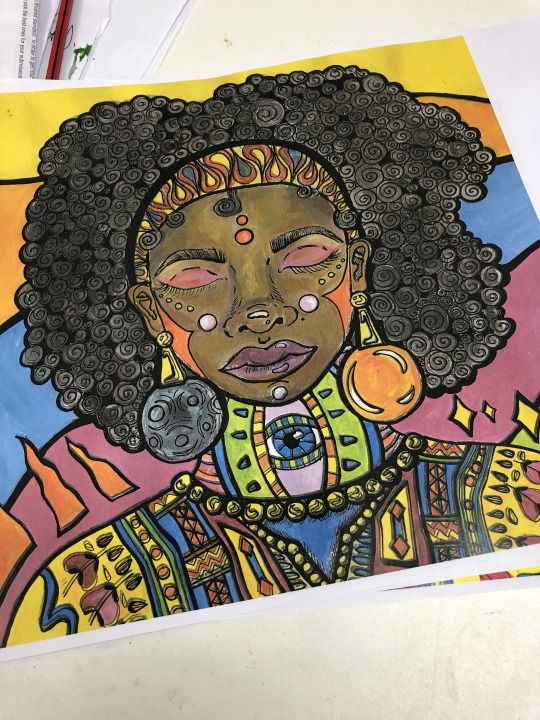
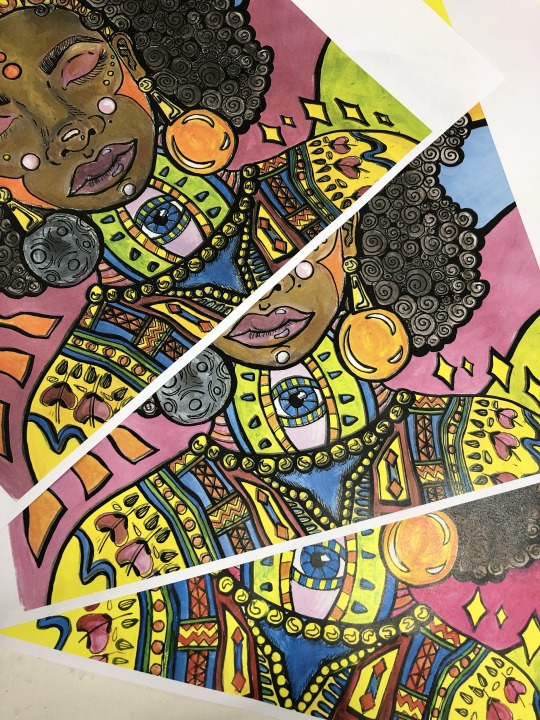
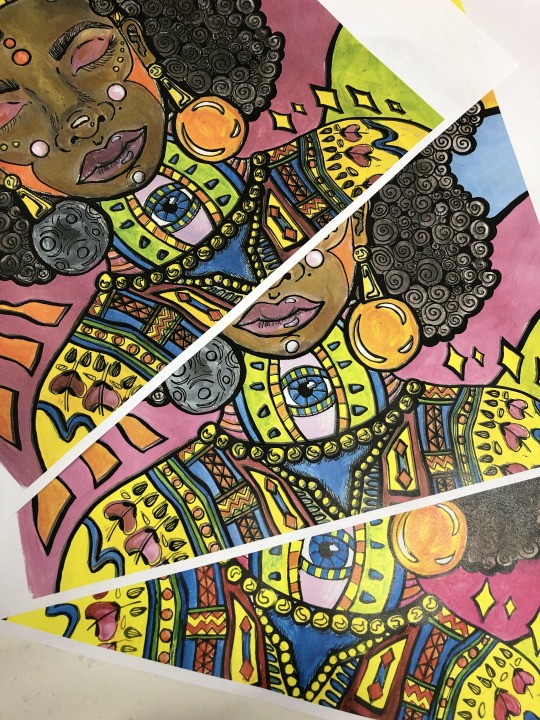
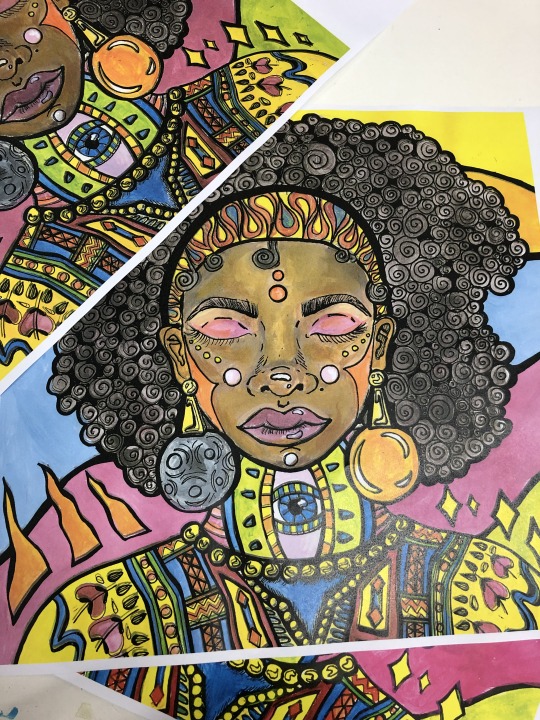
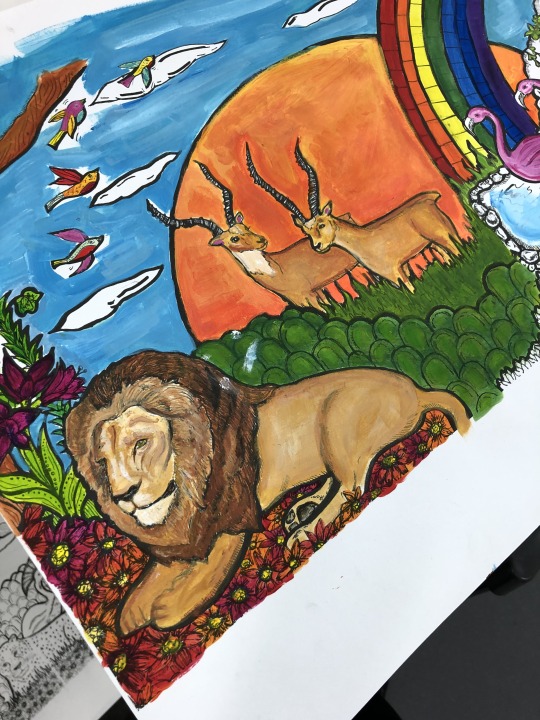
CHILDREN’S BOOK
For a project for martin we made a children’s book. I did mine based on a traditional West African myth on creation. A tale about Mawu, the Goddess of creation. Although this particular part was not for Paul’s work linking to identity it ties in well with my theme anyway. I wanted to create work which highlighted an aspect of my culture my identity, being part Nigerian and creating artwork which were black positive images. A book for children to read through and dream and be in a land of the mother land. And highlight some of the beautiful animals and wildlife that are in Africa. Visually soaking up culture, and animals and learning a traditional mythology all within just reading through a picture book. I will upload more photographs as I finish the book.
I’ve spoken about the need for representation and for children to have something to look up to and identify with. Growing up and having world book day, I never felt I had anyone to dress up as, none of the books I was reading had lead black characters. And I don’t remember having books on subjects like race, or empowering women or Africa. So I wanted to create positive artwork and colourful artwork. Also the main characters are women - the goddesses are all beautiful and the main characters are black women. And that was another reason that I chose this story.
0 notes
Text
MY PRESENTATION- IT’S NOT JUST A HAIR STYLE
My topic is identity. My project has mainly focused on how race and gender are part of my identity. I’ve looked at other black artists, feminists and how important I think that those communities are and how they impact me. But also how being a person of colour, being mixed race, and a woman have affected me. And addressing somethings like my hair growing up and my hair now as a part of my identity and also about inclusivity, wanting to see people who looked like me growing up in books and on television. I’ve been exploring this from a personal perspective and also looking at other theorists and also artists who look at similar themes.
For a lot of people culture, race , ethnicity is part of their identity. Its part of your history, your lineage and for some people a huge sense of pride. For my presentation I will be focusing on a reading called “ Hair matters”.
Below there are some terms in the reading and terms I will use to discuss my topic.
CULTURAL APPROPRIATION-
“the act of taking or using things from a culture that is not your own, especially without showing that you understand or respect this culture:"
BLACK FACE-
“black makeup worn (as by a performer in a minstrel show) in a caricature of the appearance of a black person
also : a performer wearing such makeup
NOTE: The wearing of blackface by white performers was, from the early 19th through the mid-20th centuries, a prominent feature of minstrel shows and similar forms of entertainment featuring exaggerated and inaccurate caricatures of black people. Its modern occurrence in imitation of such performers is considered deeply offensive.”
WHITE PRIVILEGE-
“the fact of people with white skin having advantages in society that other people do not have:
The concept of white privilege explains why white people have greater access to society's legal and political institutions."
MELTING POT-
“A melting pot is a metaphor for a society where many different types of people blend together as one. America is often called a melting pot. Some countries are made of people who are almost all the same in terms of race, religion, and culture. Historically, it is often used to describe the assimilation of immigrants to the United States.[1] The melting-together metaphor was in use by the 1780s.["
CULTURAL EXHCHANGE-
“provide an opportunity to explore other cultures, traditions, customs, beliefs, societies, languages and much more. Hence, such opportunities make you view the world with a different lens. This provides alternative perspectives! It broadens one's horizons and increases the tendency of acceptance. “
TRANS-CULTURATION-
“ is a term coined by Cuban anthropologist Fernando Ortiz in 1947 to describe the phenomenon of merging and converging cultures.”
THE READING-
these extracts are from a book called Hair Matters, written by Ingrid Banks in 2000.
The reading I will look at further and more in depth in my blog. But I just wanted to refer to some parts from these extracts, which build a picture of how hair plays a big part in identity for other people.
The introduction explains there’s a lot of anecdotes from different people. And “ their experiences with hair, intersecting with race, gender, motherhood, freedom, law, appropriation and identity”
Straight away it highlights all the issues surround hair and black women. It is not as simple as just hair- it can cause discrimination, law suits with work or education, cultural appropriation, gender and hair length, and cultural aspects of how women wear their hair. And how all these different personal experiences build a very individual picture of what hair means to them and how it plays a part in their identity. And because it can be individual and personal how these discussions need to start .
In some instances for people of colour hairstyles can result in certain prejudgments being made and stereotypes being assumed. The extract states “ I infer that hundreds, perhaps even thousands of Afro- wearing Black women were arrested, harassed and arrested by the police, FBI and immigration agents during the two months I spent underground” which is in reference to natural hair at the time immediately being associated with “ radical black groups”. And today, other assumptions may be made about class, hygiene, and other things based on someones dreadlocks or braids. Also resulting in discrimination and job loss.
“ Understand how hair meanings represent broader articulations about beauty, power and a black woman’s consciousness “ then going on to explain the consciousness as something“… that represents difference and the multiple realities that black women face” and that “ A social and political history and reality exist that constitutes what is meant to be black and female within a racist and sexist society”. Showing that a hair style should not just simply be taken at face value. That it can be a paving journey for some women to finding self love, or acceptance. It can be a hair care change or be and this is known as a “ hair journey” for many black women. And say how their hair can define their “blackness”. Whether there’s a certain image of the time period or wanting to look different and stand out like the afro , where the civil rights movement inspired people to wear their hair naturally.
And even though this book was written in 2000, I would like to highlight the relevance. This month, February 2019 it was made illegal to discriminate in a work place for people of colour in New York City. Which is shocking to me because that means it is still legal in many states to fire an employee based on their hair in other states in America, in 2019. People are loosing their jobs for what is a hair style. Below are some extracts from the reading “ hair matters” where I have got the quotes from.
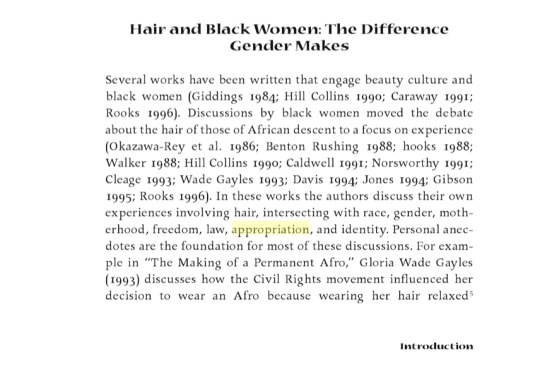
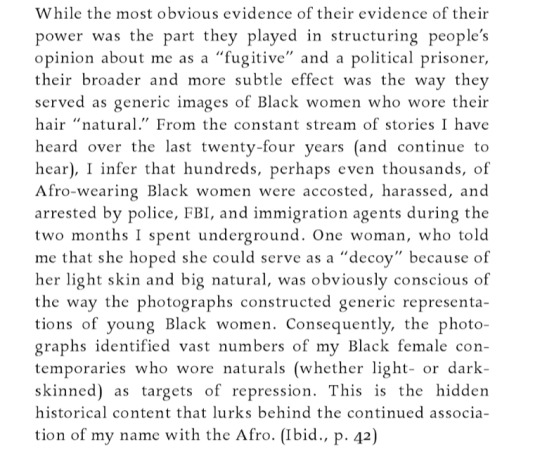
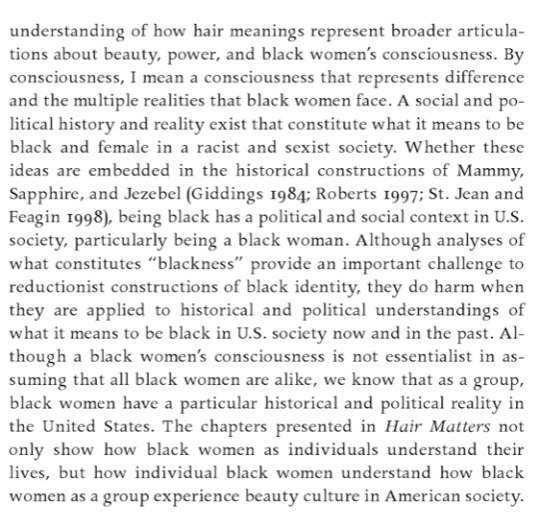
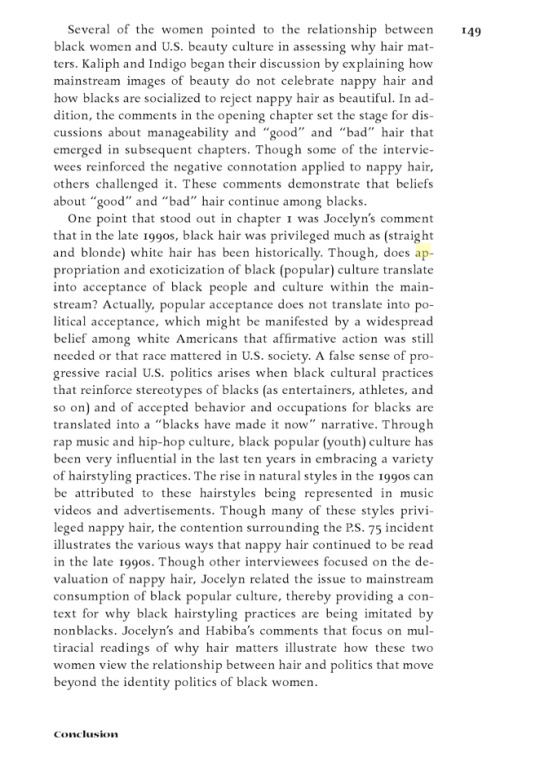
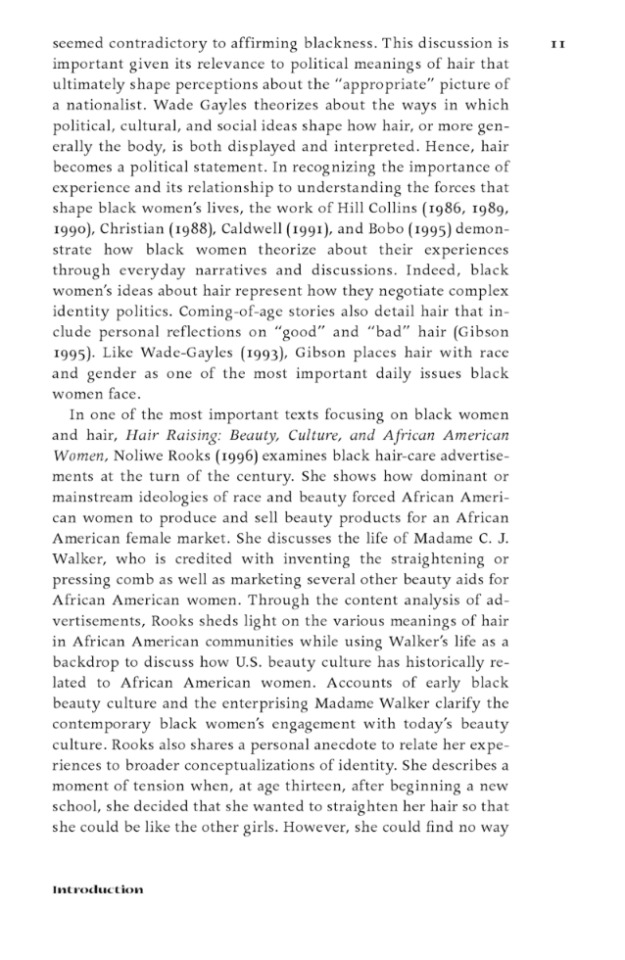
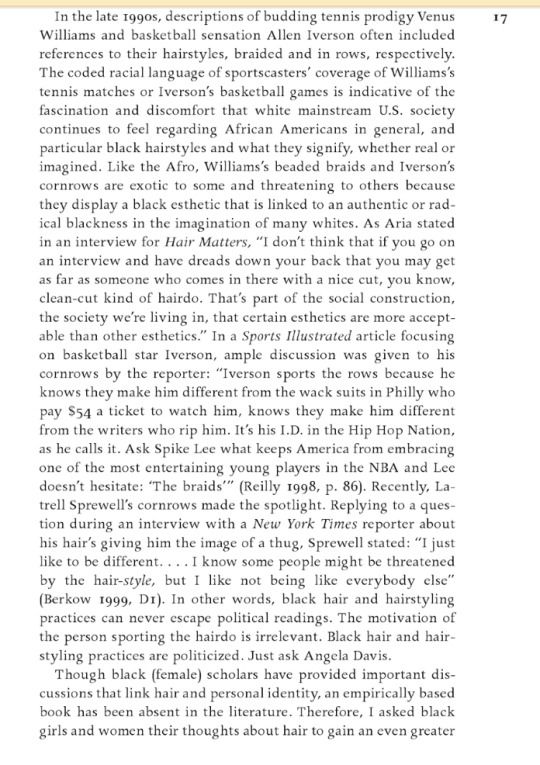
Personally I can’t agree that when it comes to dreadlocks and braids that “ its just a hair style”. The problem stems from generations of discrimination but also the Eurocentric beauty standards. When for two reasons it isn't as simple as that for us. One there may be generations of culture or history behind that item of clothing and/or hairstyle.
Two, for the fact that it would be nice if it was “just hair” but the simple fact it isn’t unfortunatlety. But there are literally thousands of articles and stories of people being discriminated against for having dreadlocks or braids. From being kicked out of school, loosing a job, all because of a hair style,. Furthermore, for many this hair style may be used as protective styling for many people, braids and cornrow are to maintain the condition of their hair and essential in order to manage their hair. Others have their hair for spiritual reasons, like dreadlocks for people who are Rastafarian.
To go further back to slavery cornrows were used as a protective styling and essential for them. They were only allowed one day of the week, Sunday. To do their hair, which meant they had to maintain the same style for a whole week. And this was after a few years. When slaves first were taken to America they were forced to shave their heads. Which stripped them of any choice, any identity. Because from the tribes in Africa people coloured their hair, weaved materials into their hair and braids which were used to signify who you were, where you were from and your status in the society.
The problem sets in when this is normalised or ‘white washed’ it in turn wipes away the culture. In this photo Kim Kardashian is wearing Fulani braids. I Some may argue that she has a black husband and mixed race children, and she wants to be inclusive. But the problem prevails when the disregard for where it came from arises.
But Kim posted the photo on Instagram with M followers she said “ bo braids”...
*Fulani Braids come from the fulani tribe. “Fulani. Fulani, also called Peul or Fulbe, a primarily Muslim people scattered throughout many parts of West Africa, from Lake Chad, in the east, to the Atlantic coast. They are concentrated principally inNigeria, Mali, Guinea, Cameroon, Senegal, and Niger.” https://www.britannica.com/topic/Fulani
However, the Bo braids Kim was referring to was in reference to actress Bo Derek who had Fulani braids for the 1979 film 10. She said in a video she's wearing “ bo braids” and “ she's really feeling this look”. Not only is it not the correct term, or giving recognition to where it actually originated from. But after the film 10, people of colour were getting fired from jobs for their hair style. Even having court cases rejected because the court deemed people to be “ copying from the film not culture” . And thats where it becomes a problem, because bo Derek had the opportunity to be “ deliberately provocative” and wear a black hairstyle at the time was un common. And it became a trend, a trend which had repercussions for the lives of black women. Who were wearing their hair in a style of their culture for maintainace, protection or even just styling, were denied the right to do so.

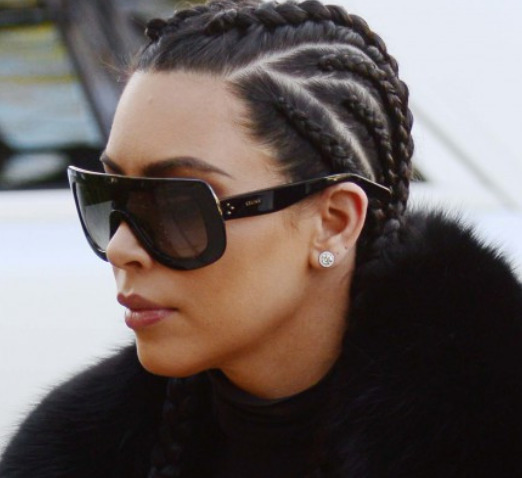
And still from 1979, it wasn't learnt that this blatant disregard and ignorance for black culture, is damaging. Kim references it in 2018 as “bo vibes” as if its history repeating its self and no-one has learnt.
What is evident is that designers have a blatant disregard for consideration of their customers who are of colour, their customers who and worse, an almost arrogance amongst the fashion industry to continually insult and disregard the feedback and backlash that they recieve from the black community. And for me that comes from a stand point of being in the position of a white privellage. Where it is allowed to disregard and not consider the effect on the black community .
And then theres the infamous Marc Jacobs SS17 runway show where he had all his models wearing dreadlocks attached to their heads. Which caused a lot of controversy.
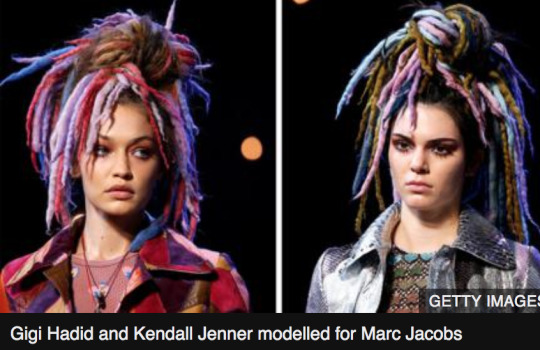
Designer Marc Jacob responded “ funny how its not a problem when people of colour straighten their hair”
Firstly not all “ people of colour” have curly hair , many hair textures which vary between person to person. Not only is the comment ignorant to the disregard that P.O.C can have straight hair it is worsened by the fact that “ straightened hair” is not a culture, it’s a genetic factor, similarly to having curly hair. Because it is not a culture it is not being appropriated. DR DELICE said that cultural appropriation "happens when there are power inequalities between different cultures” and that is the problem here. Furthermore, this is comment comes after years and years of people believing that it was more desirable to have straight hair. Generations of instilling that it is better to be white and more beautiful to be white. Even after slavery was abolished and black people were moving from Southern States more North to cities like New York. And it was encouraged to wear wigs and perm your hair as it was seen as more Hollywood more glamorous. Women used knives and hot combs to get straight hair back in the 1800’s and then later in the 1860’s people were using potato, egg and lye. Which often caused severe burns to the scalp . People went to extreme lengths to conform to beauty standards and these attempts often resulted in people loosing their hair https://www.bustle.com/articles/189044-a-brief-disturbing-history-of-all-the-times-society-straightened-afro-textured-hair . And therefore, I believe the criticism he received was justified because even when confronted on the matter Marc Jacobs, did not credit where the style was influenced from him and his stylist said “ rave culture” and then made his uninformed remark about straightened hair.
Marc Jacob in ANOTHER instance got recignition for the “ mini bun” a “ new trend”. Which is also known as bantu knots.
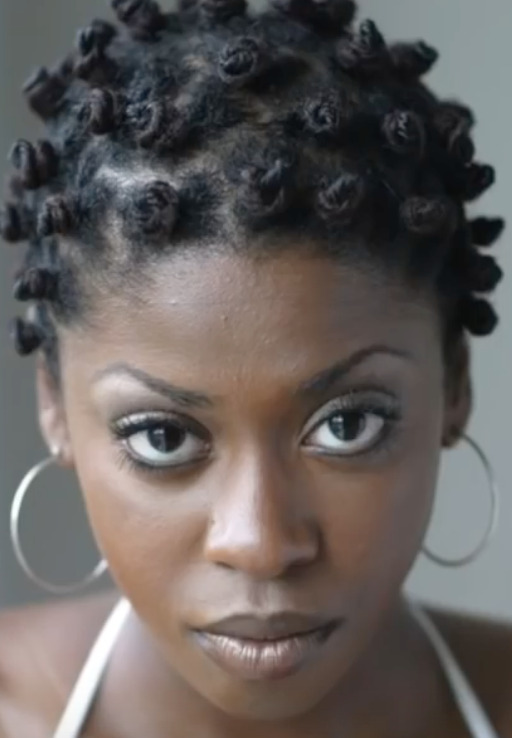
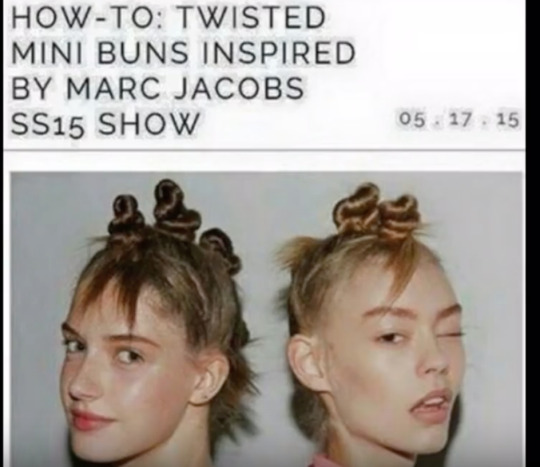
Jane kellock works in the fashion industry, she has worked for Topshop and many other brands.She said...
"Design is a mish-mash of different styles, cultures, ideas - and that's what makes it interesting," she says.
"I really, genuinely don't think that designers look at other cultures and think 'I'm just going to copy that and I'm going to rip off that culture'."
JANE KELLOCK- https://www.bbc.co.uk/news/newsbeat-46297329.
Which I believe would be a lot of peoples response that cultural appropriation is sometimes appreciation. And a lot of people may consider that in the world we live in, that there is an amalgamation of people and cultures and that its only right to share and appreciate what else is around you. And I am not suggesting that all designers deliberatly “ rip-off” cultures. But whether intentional or simple ignorance the problem still stands, it is happening.
But she then went on to say...
"Fashion brands have to be more aware and diverse in general, because they're not. They're really not.”
"They'd rather use a celebrity that they know will get lots of people interested in it, rather than the original source of the idea.”
"In most cases, unfortunately, designers don't even have time to undertake proper research and appreciate a culture.”
She acknowledges the lack of diversity and inclusivity for P.O.C in these industries.
Going back to the earlier point about Eurocentric beauty standards. Even amongst the black community there are issues surrounding colourism, without including other races. There is an ideology amongst a lot of people of colour that it is more desirable to be lighter it is more desirable to have a paler complexion than to be a dark skin woman. Which is relevant again for me and my project more personally women of colour. There is often a sense of inadequacy. I didnt really notice too much until I was older the distinction with “ light skin “ or girls being “ lighties” and this being a sexualised preference for some men. And also the term “exotic” and the derogatory undertones of highlighting that essentially you’re “ different”. That the lighter you are the more attractive you are which also ties into hair. Black hair is often described as messy, nappy, frizzy often quite negative descriptions people pay a lot of money to get hair relaxed, treated or wigs or weaves to achieve a different look. And of course, for a lot of people this is a choice, and some people do like change. But it stems from certain beauty standards which we are upheld to. With hair shops throughout the UK selling bleaching and lightening creams and even ‘celebrities’ like Blacc Chyna selling lightening cream in Nigeria to impressionable followers, who will believe this light skinned sucessful rich blonde woman is the standard of woman they’re against.
As it said in the extract also black hair comes with stereo types and labels. And after years of women trying to conform to the Eurocentric beauty standard people do wear their natural hair more than in previous decades and it is frustrating to often hear these styles are ghetto or hood or ratchet but may be called “ urban” “raw” when not referring to a person of colour with the same styles.
Recently more so there has been a celebration of natural hair, curly hair, with yearly conventions like “ CURL FEST” and other festivals encouraging embracing who you are and what you were born with . A lot of people are transitioning their hair back to natural and stopping using harsh relaxers which are very damaging to afro hair.
On top of all of this, I think that there’s also a blatant disregard for black customers and black people in general for a lot of high end brands.
Recently a lot of designers have been called out for creating racially insensitive clothing . Even last month, it was Black History Month and people were highlighting on twitter and other social media platforms which then led to the companies often removing the stock and following with some kind of apology. But Prada, have released the “ black monkey red lips” Gucci last month the black balaclava with red lips, chanel and their urban tie cap ( du rag you can get anywhere for a pound) , D&G and their $2,395 SLAVE flip flops, Moncler and their “ penguin Malfi, from friendswithyou” a campaign from Moncler who said the aim was “global friendship”, and Burberry and their “noose” which people were offended at the history of lynching and even insensitivity also towards suicide victims.
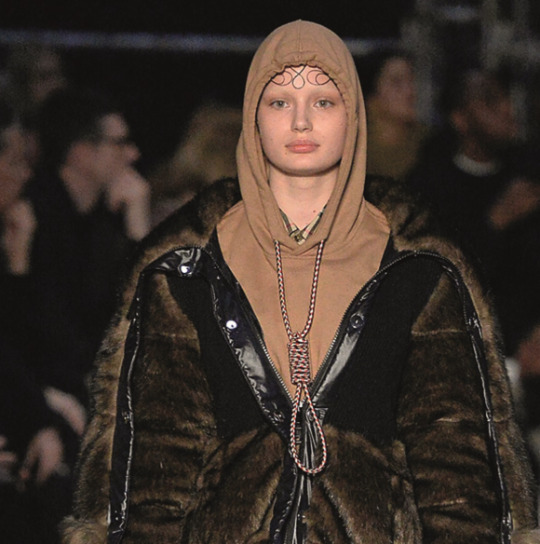
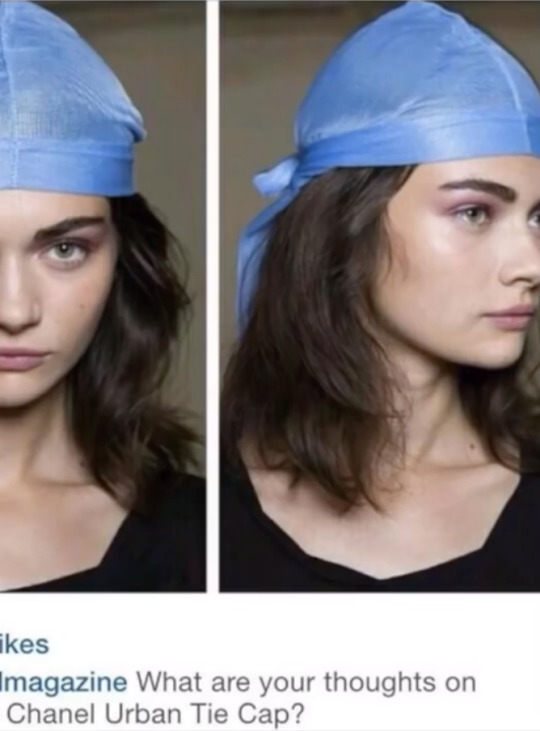
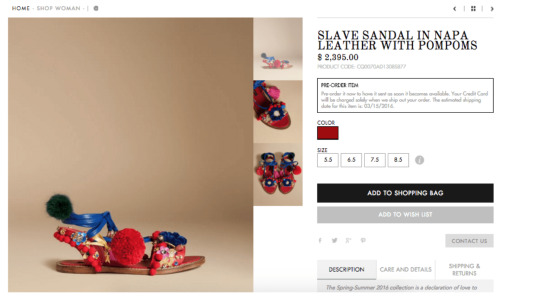
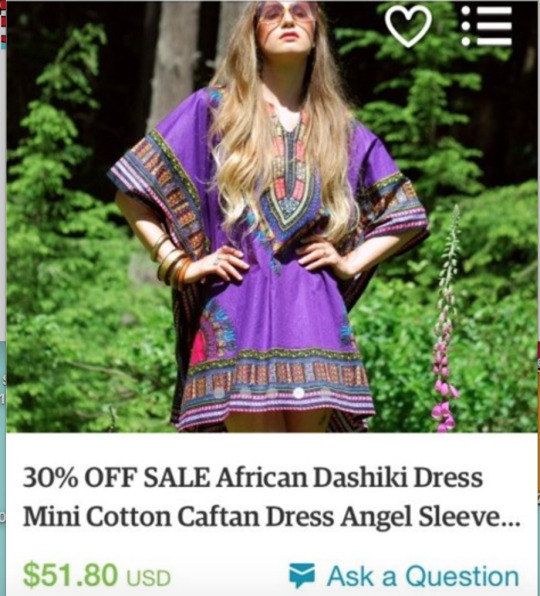
These brands announce diversity education and initiatives in order to “ stop these kind of events happening again”. But it seems unnecessary for these things to ever occur in the first place and to believe its even accidental in the first place seems naive. And makes it hard to want to “share” braids, and dreadlocks, and dashikis when high end brands also sell wolly wog printed items and blackface.
So it calls me to ask how will society move forward as a melting pot of cultures or a society built on difference but acceptance. Holding the title ‘ white privilege ’ isn't a fault of anyone now but it is deep rooted into society but to me, it should just be handled well and with consideration. And SHOULD therefore prioritise the other cultures before taking casual wear and someones hair style at face value. And to wear it as though it is simply just a costume, or just an accessory. A lot of people will argue its not our job to educate others, but I think it’s good to start the discussion .
0 notes
Text
TRACEY EMIN @whitecube
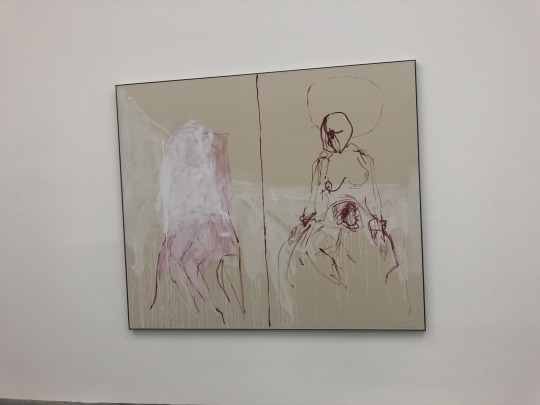
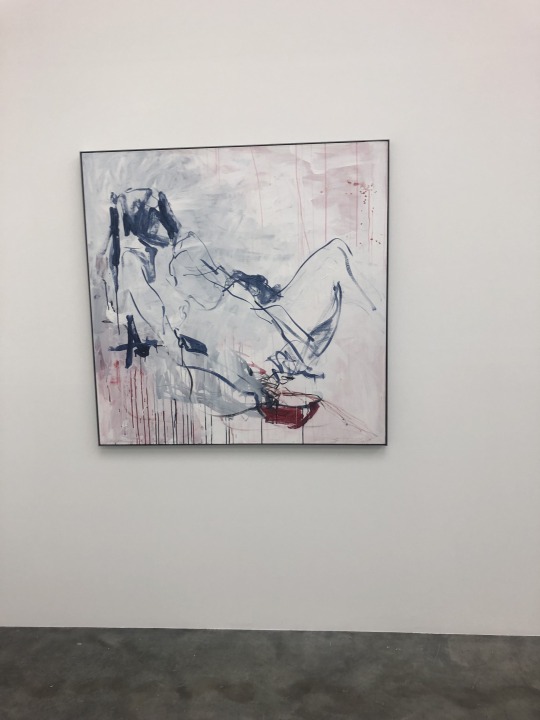
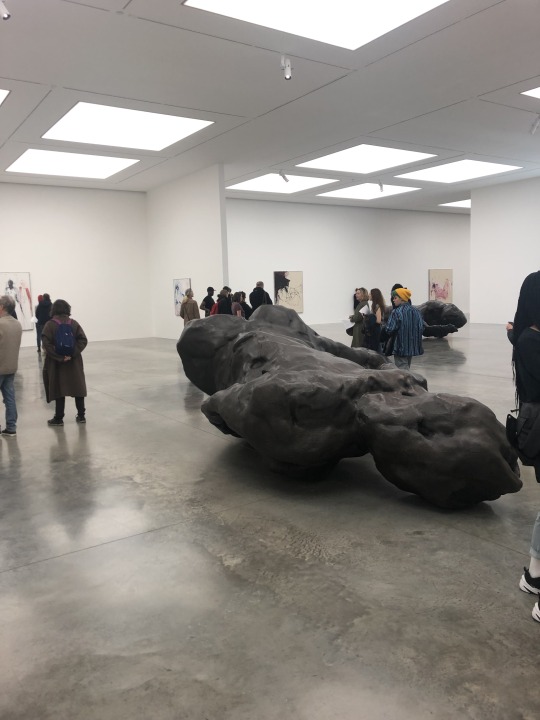
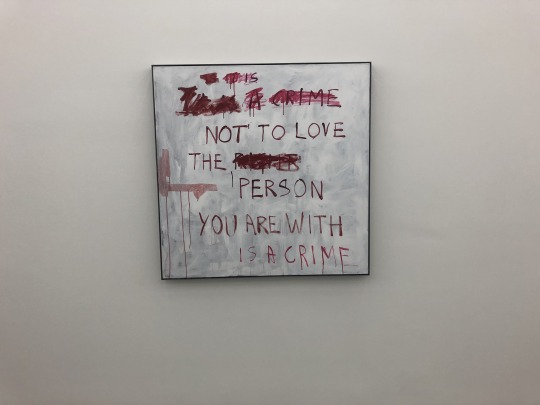
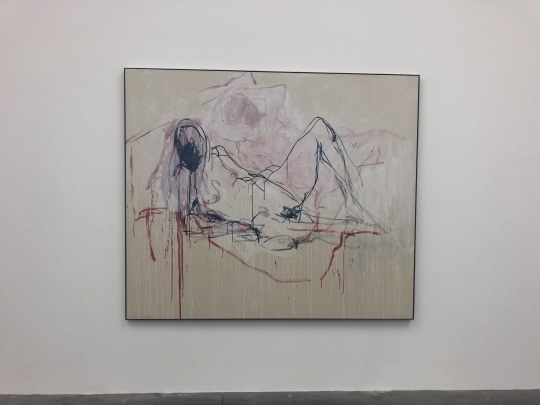
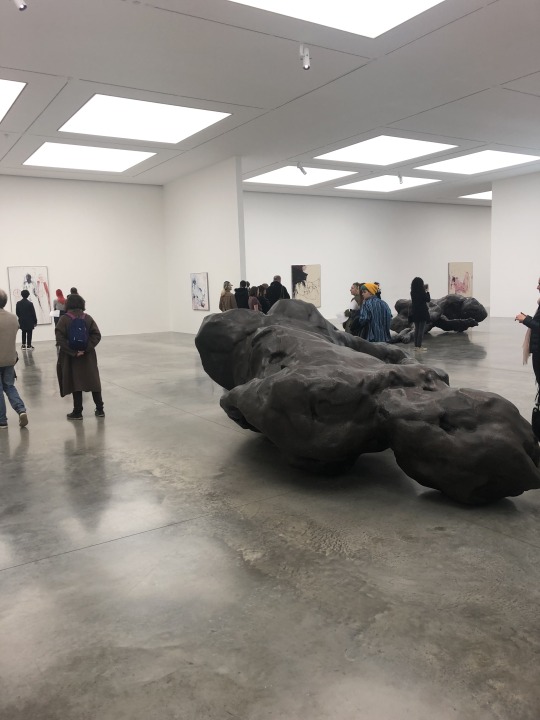
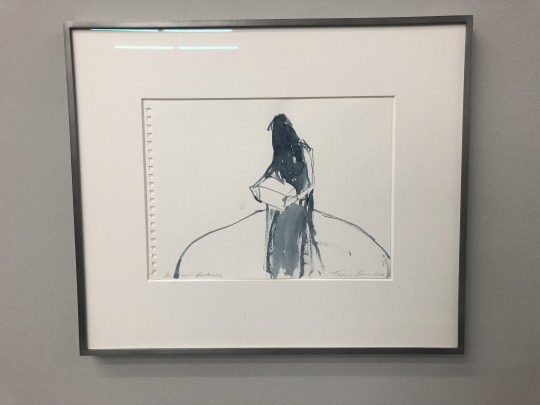
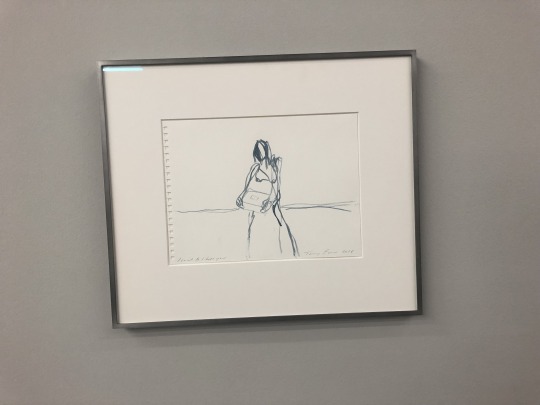
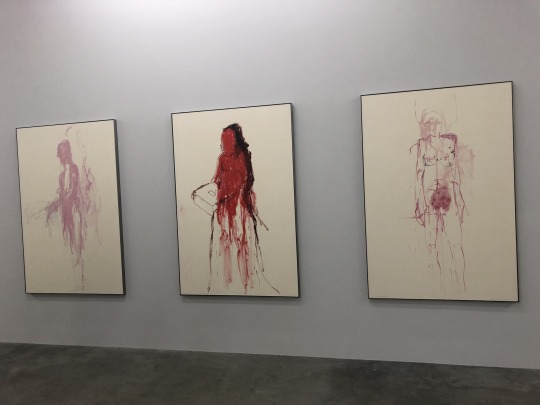
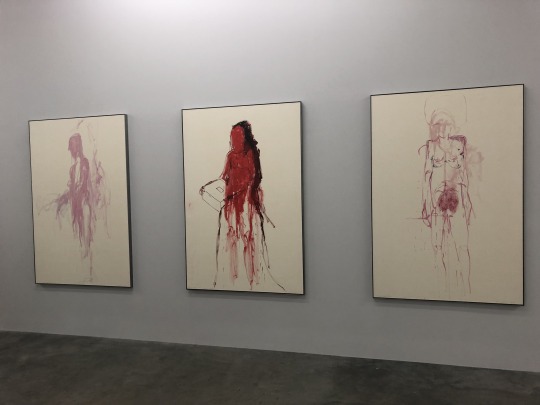
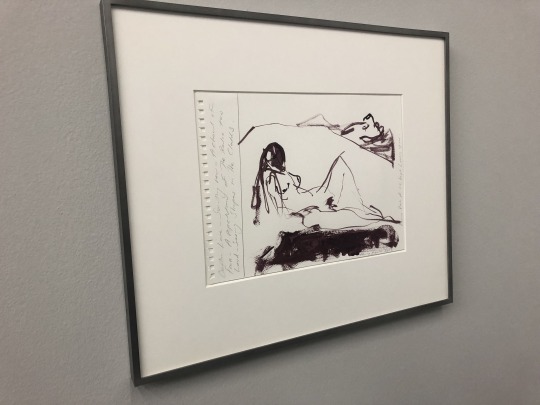
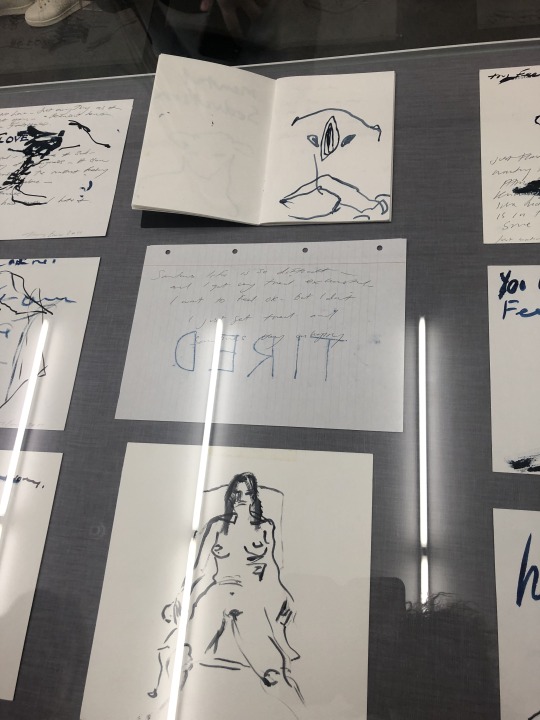
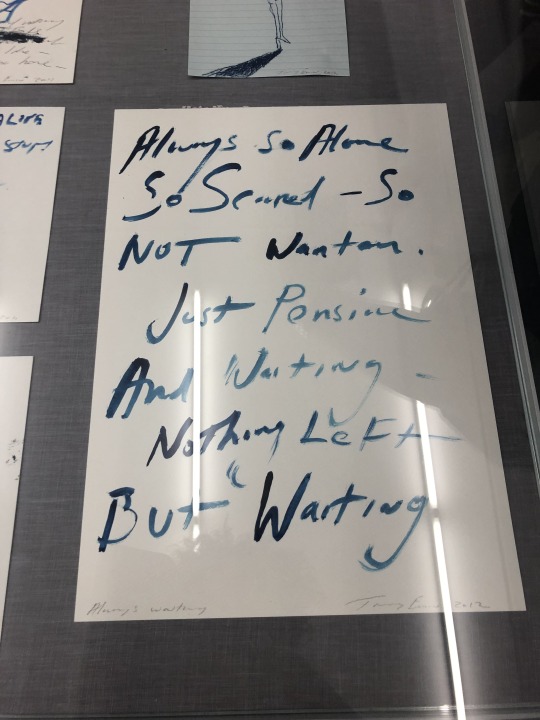
I wanted to visit some exhibitions centered around feminism. The White Cube in Bermondsey is presenting Tracy Emin’s exhibtion “ A Fortnight Of Tears”.
Tracey Emin is a British artist and she works in a variety of mediums and does drawings, painting, sculpture, installation ( neon text) and film. All of which was shown in the exhibition. I think that the work in her exhibition was a brilliant exploration for my theme identity. Emin speaks on very person issues in regards to sex, being a woman, abortion and death. And gives a very raw in depth insight on her life and her mind. This is also a reflection on society and life and how she fits into this.
Emin further explores identity through a whole exhibiton space filled with selfies, of her in her bed. She suffers from insomnia and it shows her expressions pasted enormously on the wall so you really feel overwhelmed by being surrounded by these solmn and sad looking photographs, which perhaps what Emin is hoping the audience will empathise that this may be how she feels.
The exhibition has an almost cold feel. But it is also very real, Emin has notes, scribbles and journal pages with thoughts and feelings. Getting more personal Emin describes her anguish after having an abortion and part of the exhibition was a 22 minute long video where she re visits places of significance during her abortion. She shares very intimate details of her thoughts and feelings and it is very insightful.
Emins work if very expressive and And feel the emotional release she feels as she It is a very emotive display of work. Lots of scarlets and salmons and then lots of deep blues.
Aswell as her paintings theres also sculpture and she has neon lights in there too.
This was also a free exhibiton and I would definately reccomend it. Here are some photographs that I took at the exhibition.
0 notes
Text
MY WORK- DEVELOPMENT
I have created a list of more women who I have looked into but would like to do further research and find more information on them.
Sonia Boyce
Rosa Parks
Belle Hooks
Coretta Scott King
Audre Lorde
Alice Walker
Oprah Whinfrey
Saraah Baartman
Maya Angelou
Frida Kahlo
Angela Davis
Yayoi Kasuma
Malala Youdefzai
Adichie
Janet Mock
Lilian Bader
Margrey Busby
Malorie Blackman
Dr Shirley Thomson
Pat MCgrath
Lubainia Himid
Amy Sherald
Claudette Colvin
0 notes
Text
CONTEXTUAL REFERENCE- GUERILLA GIRLS
The Guerilla Girls are an annonymous feminist group. They were formed in 1985 and their main focus is gender equality and racial equality. They remain annonymous because they believe that the issues they tackle are more important than their identities.
I love what the Guerilla Girls stand for and also activist art. I have seen their work in London at Whitechapel Gallery. And although their work is from the 80′s/90′s their work is very much relevant. And about the discrimination you face as a woman and as a person of colour. And recently it has shown that the galleries than show 10% of women now show 20% and one of the members known as “ Frida Kahlo” said “The Whitney museum says, ‘Isn’t it wonderful – we have 30% women in the new collection!’And we’re saying, why is that something to be happy about – 30%? Where is the other 20?”
The study which showed the 10% rise was in 2014, so really in almost 30 years isnt masses of improvement and it certainly isn’t equal. Which is definately something that needs to be discussed. More oppertunities, more equaility .
There needs to be diversity and equality in the art world and there needs to be more positive role models for us to have something to strive for. Someone who you can relate to and understand and still see that they have been able to make it. And thats why I want to create these pieces to give young people inspiration and know it is possible.
And hope with time and education and equal oppertunity that it will be 50:50 before it gets to another 30 years.
I also have seen their book Death of the Artist. Dissidents and their alternative identities. Which I have ordered to read also to learn more on the group.
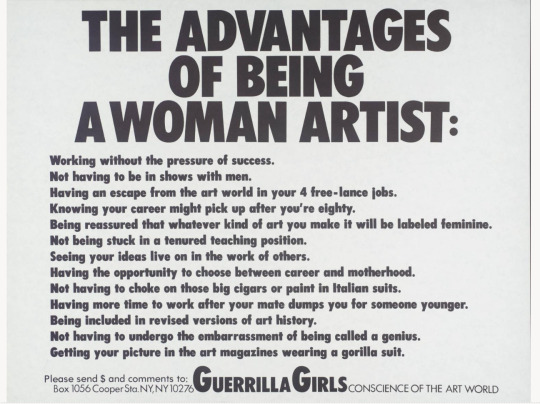
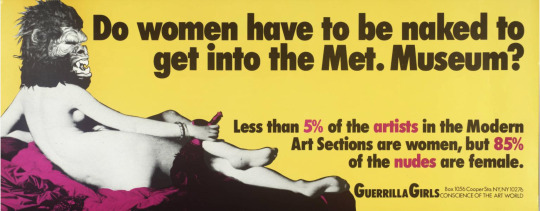
0 notes
Text
MY WORK- GENERATING IDEAS
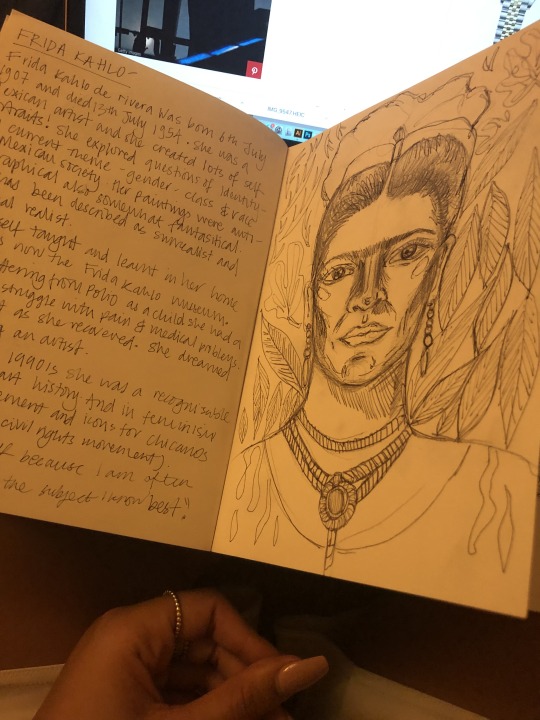
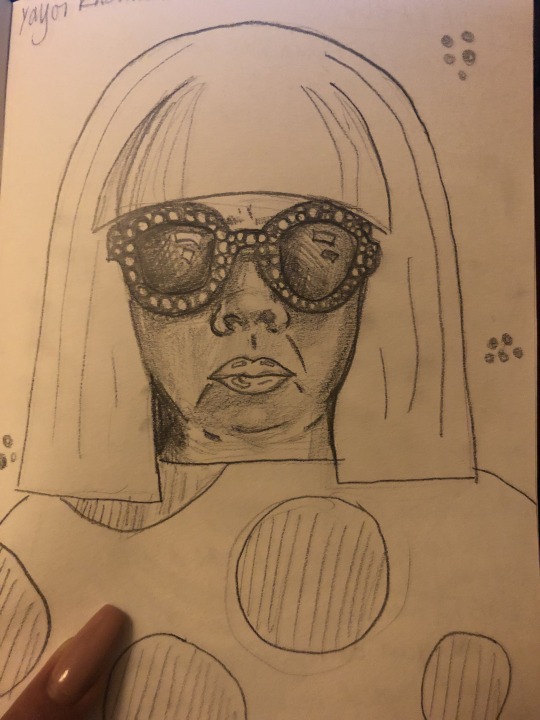
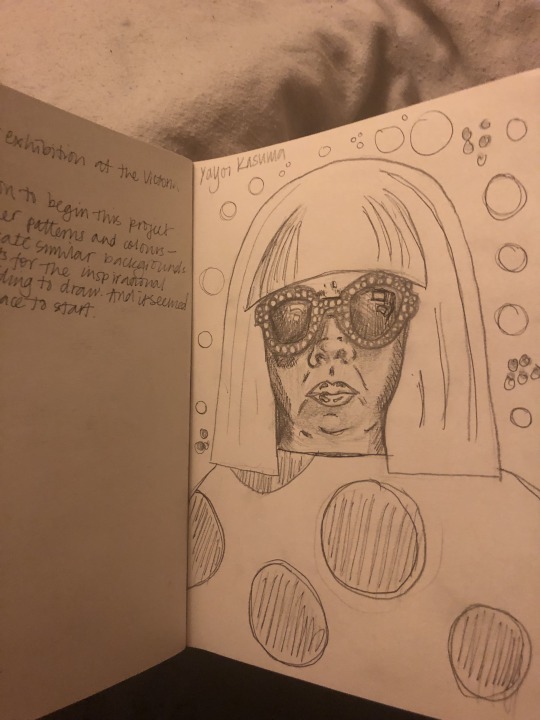
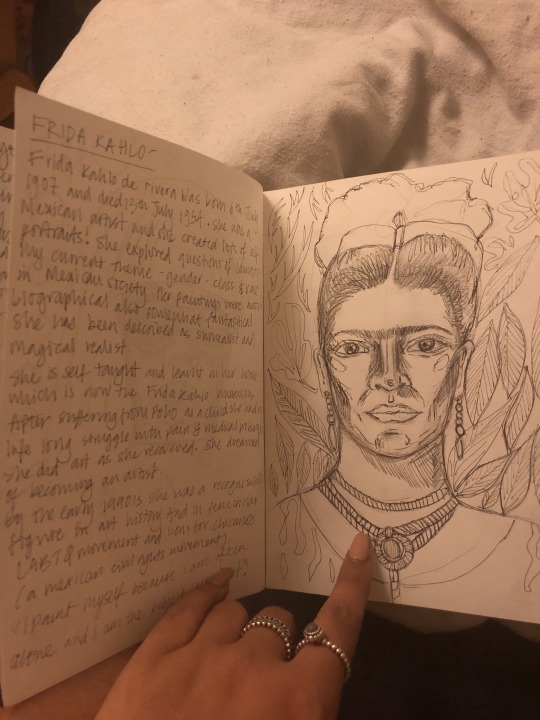
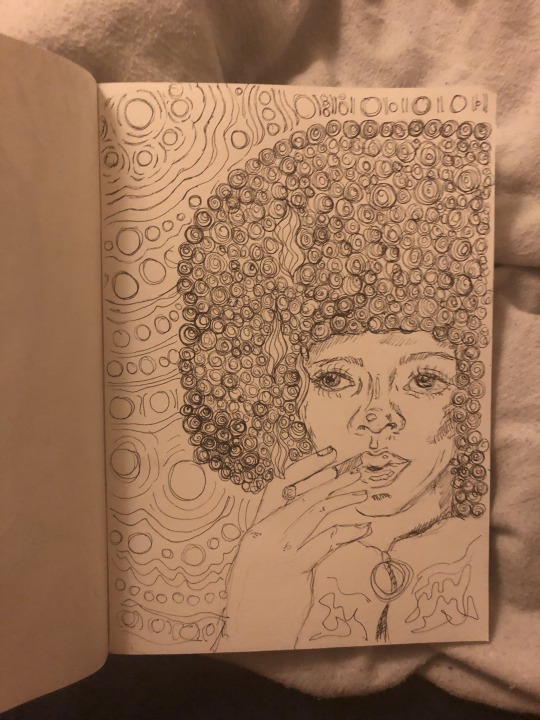
These are some sketches from my sketchbook. They are ideas for the canvas’ of inspirational women so far I have drawn Yayoi Kusama, Frida Kahlo and Anegela Davis aswell as the drawings of Maya Angelou that I did also. I will soon start developing these into paintings.
0 notes
Text
VISUAL REFERENCE- BLACK BRITISH ARTISTS SHAPING A NEW FUTURE.
i-D X PHOTOSHOP
I found an article which is i-D x Photoshop. It’s an article written from Black History month. Three artists did a collaboration using adobe programmes to create art. Necessary for social change it is a time for reflection on history and current times too and that was the aim for the collab. These were all British artists who reflected on the UK experience of being black in Britain.
One of the artists participating was Joshua Boateng who’s work I will attach below. The portraits are of Letitia Wright and Sir Trevor Mcdonald. He said “ I believe both characters reveal history can be created now, whether youre young or old, male or female. By looking at the characters that are writing the story today, rather than people in the past, I hope that it will encourage more people to make the most of the present and appreciate everyday heros”
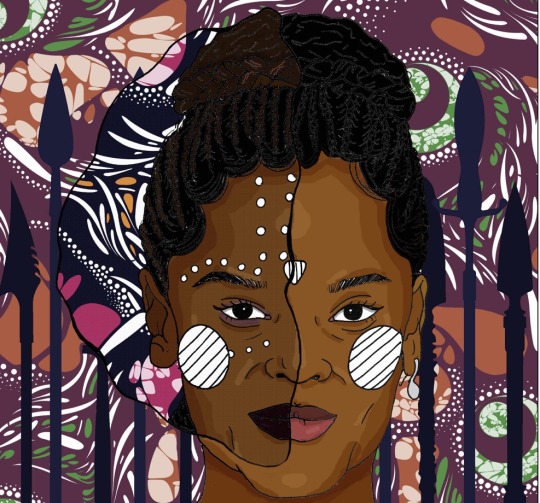
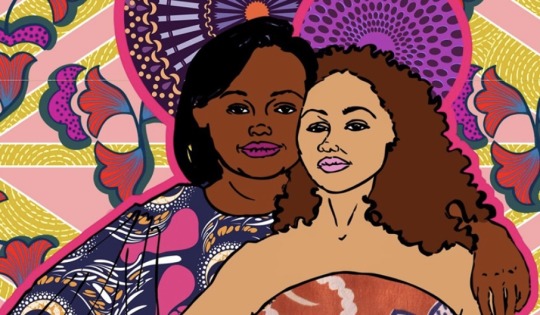
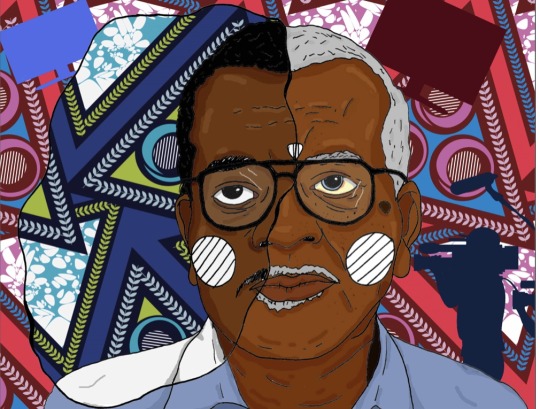
0 notes